
Updated Step-by-Step Guide How to Translate Twitter Video Easily for 2024

Step-by-Step Guide: How to Translate Twitter Video Easily
Do you want people around the world to watch your videos on Twitter? What about those who might want to watch but don’t speak your language? Without video translation, you’re missing out on reaching many potential viewers.**Translating Twitter videos lets you connect with audiences from different cultures and languages.
Translated videos also lead to better engagement. Viewers are more likely to watch accurately translated videos on Twitter. If your video has a bad translation, you could lose viewers. Translations help more people to understand your content. That way, they will have a chance to share your video. This leads to higher engagement with viewers worldwide.
If you have videos that need translating, we’re here to help and guide you through the process.
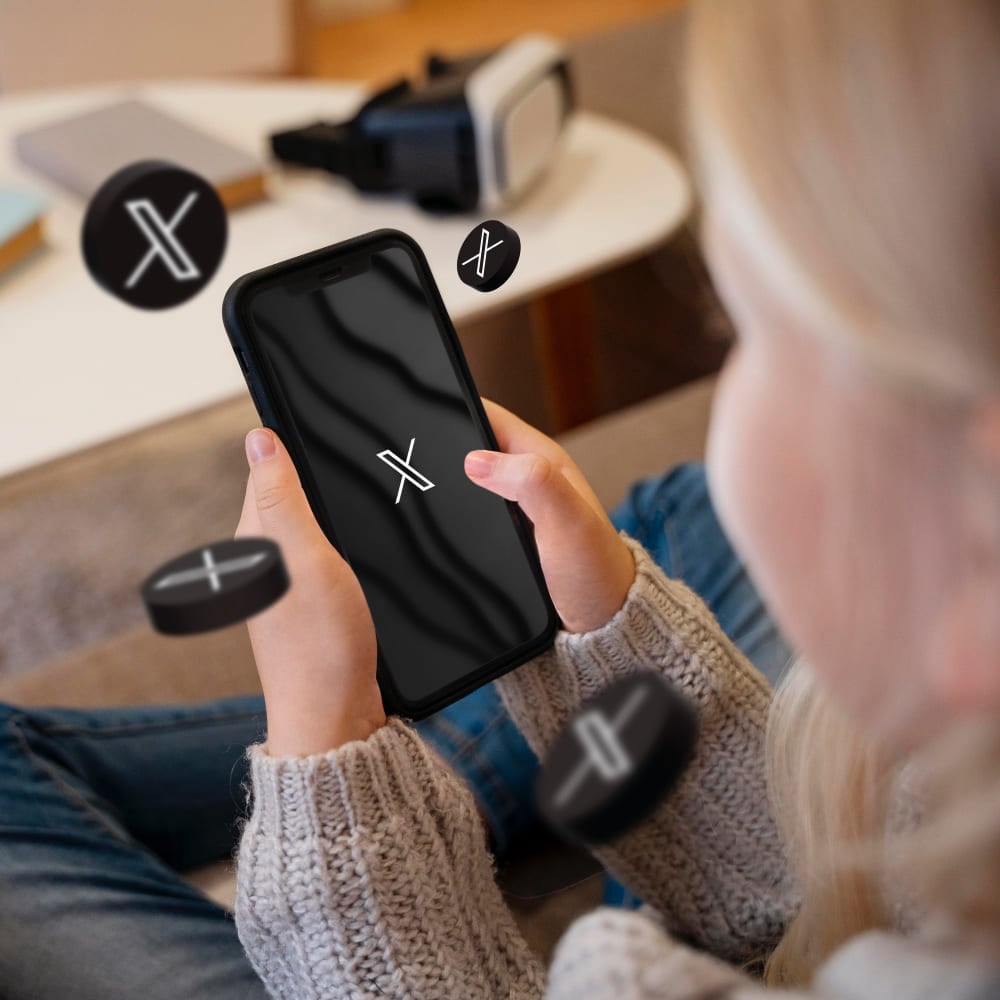
Part 1. Why Translate Twitter Video?
Twitter has a vast user base worldwide. It offers an unparalleled opportunity to connect with diverse audiences. But the language barrier often stands as a significant obstacle. **Translating Twitter videos addresses this challenge head-on. By offering many benefits beyond mere language comprehension.
Here’s some benefit of translating video:
- Accessibility to diverse audiences
When you translate videos on Twitter, you’re breaking down language barriers. So everyone, no matter their language, can understand your content. This means more people connect with you, opening to diverse communities worldwide.
- Increased reach and engagement
Translating videos helps you reach more people on Twitter. If your content speaks different languages, more viewers can engage with it. Making your message go further and have more impact.
- Building a more inclusive online community
By translating your videos, you’re making Twitter a more welcoming place for everyone. Regardless of their language. This builds a stronger community where diverse voices are valued and heard.
Part 2. Are There Built-in Translation Features on Twitter for Video?
Twitter has limited features in terms of translation. Currently, Twitter only allows the translation of text within tweets. There are no built-in features for translating video content directly on the platform. But, you can enable closed captions to aid in understanding video content.
Here are the steps to turn on closed captions videos on Twitter:
- Step 1. Open the Twitter app or website and find the video tweet that you want to watch with closed captions. This tweet could be in your timeline or a user’s profile.
- Step 2. Tap the video’s thumbnail to play the video.
- Step 3. Tap on the three dots at the top right of the screen to bring up the video player controls.

- Step 4. Look for the closed captions (CC) icon on the video player controls. It usually appears as a small icon with the letters “Captions” or “CC” inside a rectangle. Tap on this icon to turn on closed captions.
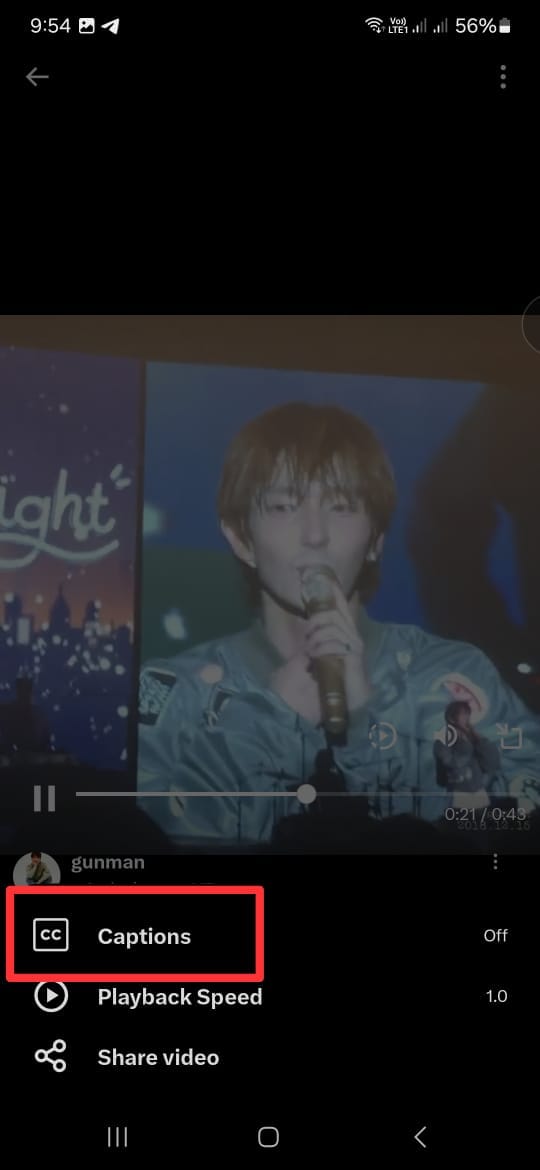
- Step 5. Once closed captions are enabled, watch the video as usual. You should see text at the bottom of the screen that provides a written transcription of the audio content.
However, closed captions on Twitter are not perfect. Not every video on Twitter shows this feature. That’s why this feature is not a popular option for many users.
Part 3. How to Translate Twitter Video With Twitter Translator Bots
Users must use external tools such as bot accounts and AI video translators to translate videos on Twitter. These tools can help translate video content on Twitter. Making it more accessible to diverse audiences. While **Twitter video translation features are limited, alternative methods can overcome these language barriers.
Using bot accounts on Twitter to translate videos involves a few steps:
- Step 1. Find a Translation Bot Account
Look for bot accounts on Twitter specifically designed for translation purposes. Some of them are @TranslateMom, @Translatevidapp, and @vidtranslator. These accounts are programmed to translate video to text-based content automatically.
- Step 2. Follow the Bot Account
Once you’ve found a suitable translation bot account, they usually require you to follow them to receive the translations.
- Step 3. Tag the Bot Account
When you find a video tweet you want to translate, reply to that tweet and tag the translation bot account. You can mention the bot account’s username and request a translation.
- Step 4. Wait for Translation
The translation bot account will automatically respond to your tweet with the translated text. Depending on the bot’s processing time and availability, this may take a few moments.
- Step 5. Review the Translations
Once you receive the translation, review it to ensure accuracy and readability. Remember that automated translations may not always be perfect. So, use your judgment to assess the quality of the translation.
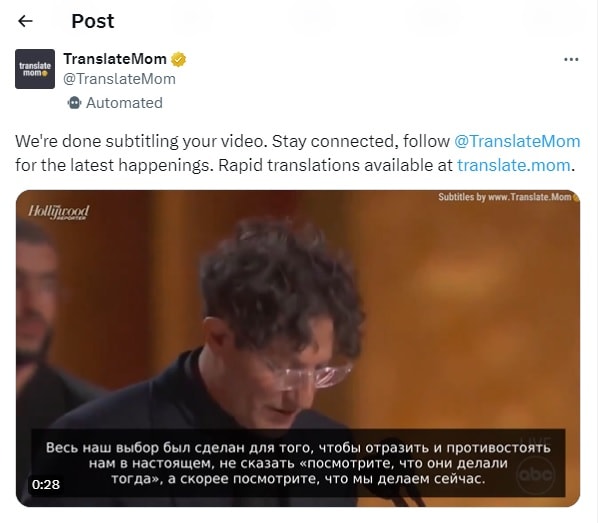
Another option that you have to translate videos on Twitter is using AI Video Translator. There are many software that have AI Video Translator features. But if you want to use those tools without installing anything, the next section will discuss how to do it online.
Part 4. How to Translate Twitter Video With AI Video Translator
One standout tool to **translate twitter videos online is by using Wondershare Virbo Video Translator . This tool is designed to translate videos and give users accessibility across linguistic boundaries.
Virbo’s Video Translator stands out as the go-to solution for several reasons. Its advanced AI algorithms ensure accurate and natural translations and preserve the essence and tone of the original content. Moreover, its user-friendly interface makes it easy to translate videos with just a few clicks.
Key features of Virbo’s Video Translator include:
- Automatic Translation
Virbo uses cutting-edge AI technology to automatically translate video content, eliminating the need for manual transcription and translation.
- Multiple Language Support
Virbo supports a wide range of languages. Enables creators to reach diverse audiences worldwide.
- Customization Option
You can customize translations to suit your preferences, adjusting language style and tone settings.
- Subtitle Integration
Virbo integrates translated subtitles into the video, ensuring a seamless viewing experience for viewers.
To translate Twitter videos using Virbo Video Translator, you can follow these simple steps:
- Step 1. Go to Wondershare Virbo and select “Generate AI Video Online .”
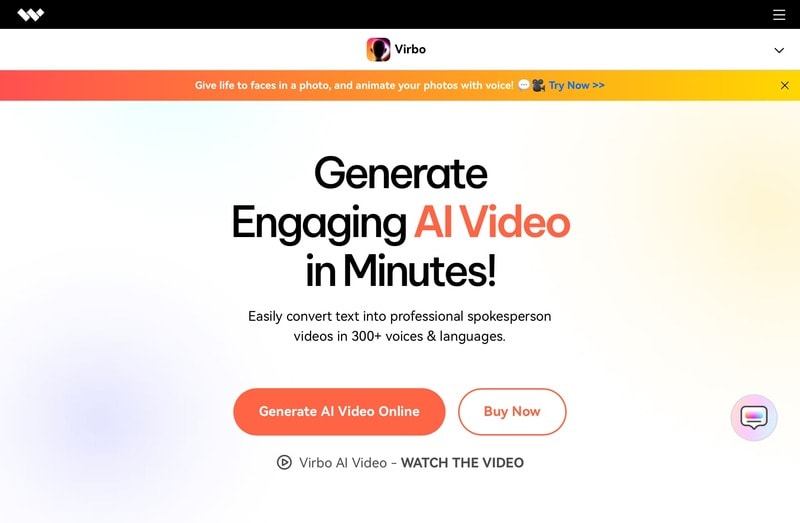
Get Started Online Free Download
- Step 2. Log in or create a new account.
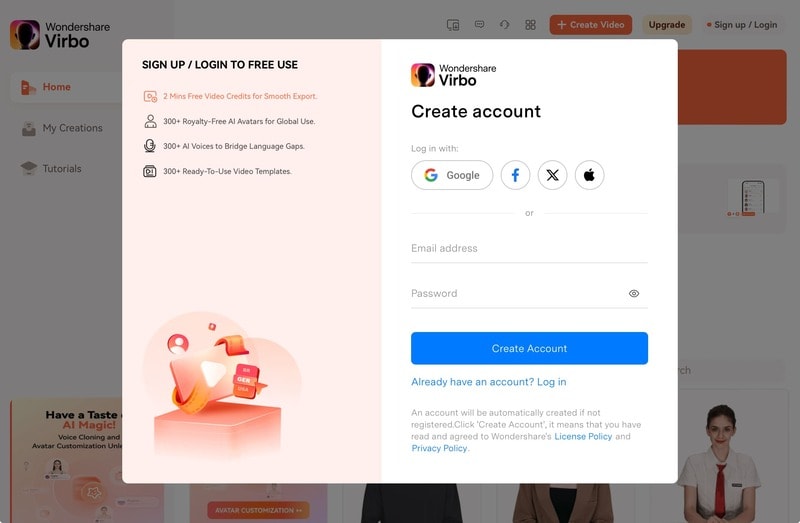
- Step 3. Open the Video Translate feature.
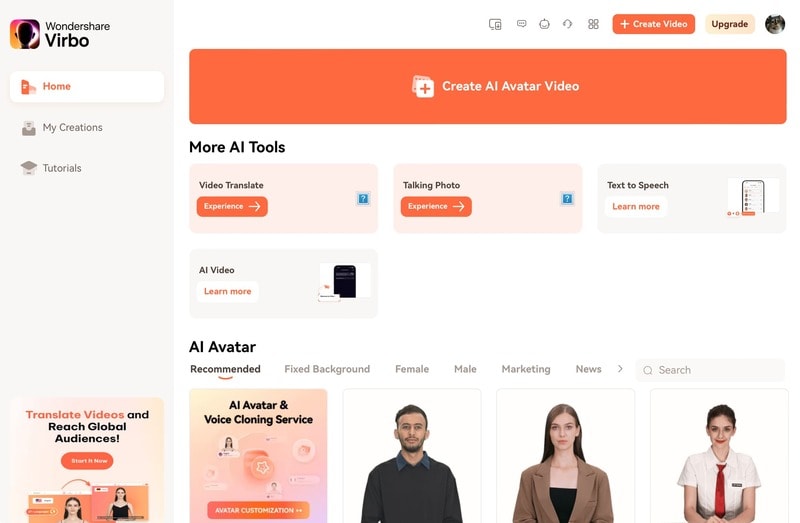
- Step 4. Upload the video you want to translate. Specify the original language and choose the target language. You can activate the Lip Sync feature for accurate audio translation aligned with lip movements or enable the Subtitle feature.
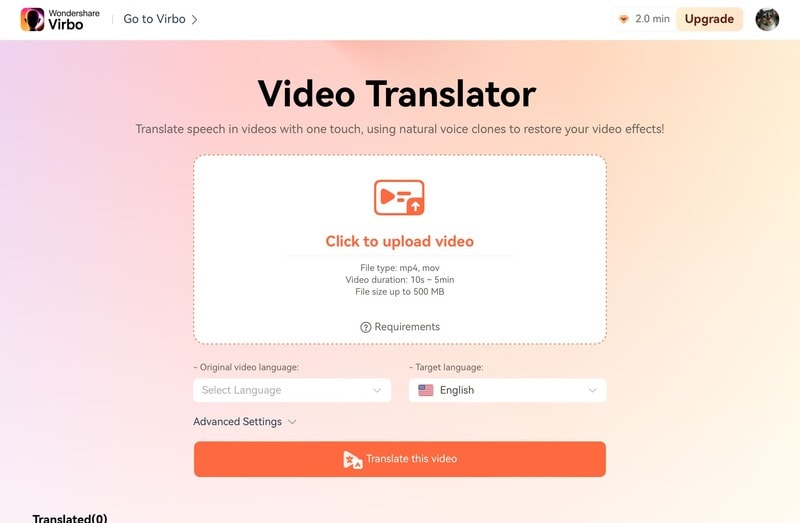
- Step 5. Click “Translate this video”, then the system will translate the audio and synchronize it with the video. Note that processing time may vary depending on the video’s duration and complexity.
Using Virbo’s Translation tool makes translating Twitter’s video online easier. It helps you reach more people and break through language barriers effortlessly. With Virbo’s smart AI technology, connecting with a worldwide audience is simple and leaves a significant impact.
Conclusion
Translating videos on Twitter is not just about overcoming language barriers. It’s about expanding your reach, fostering inclusivity, and enhancing engagement. Translating the video makes your content accessible to diverse audiences worldwide. Hence, it creates a more connected and vibrant online community.
While Twitter’s built-in translation feature is limited, other tools exist. For example, you can use translation bot accounts or AI Video Translators. One of the best solutions is using the AI Video Translator tool by Wondershare Virbo. These tools are easy to use and help you connect with people worldwide.
So, if you want your Twitter videos to reach a wider audience and make a more significant impact, try Virbo’s Video Translator tool. It’s simpler than you think, and it’s worth it.
Get Started Online Free Download

An Exhaustive List of Lip Sync Apps for Vibrant Video Creation
Lip sync apps have surged in popularity as engaging platforms for creating entertaining video content. These apps allow users to synchronize their lip movements with pre-recorded audio tracks, enabling them to mimic songs, movie dialogues, or comedic sketches. The appeal of lip-syncing apps lies in their simplicity and versatility which cater to a wide range of users.
The rise of social media platforms has further propelled the popularity of lip sync apps, with users eager to share their creations with friends, family, and online communities. Whether it is showcasing talent, creating humorous skits, or simply having fun, lip sync apps offer a dynamic outlet for self-expression in the digital age.
As users explore the features and capabilities of different lip sync apps, they can discover the best app for lip sync videos that suits their creative needs and preferences. In this article, we will explore different lip sync apps, their features, and how they can enhance video content creation. Let’s dive in!
Part 1: A Deeper Dive into Entertainment: What Are Lip Sync Apps?
Lip-syncing has evolved in the digital age, moving from its roots in music and film to a popular form of self-expression on social media. With smartphones and accessible editing tools, anyone can create captivating lip-sync videos at home. Lip sync apps play a crucial role, providing intuitive platforms for crafting engaging content. Users can choose audio clips from vast libraries and sync their lip movements using simple editing tools and effects.
Lip sync apps is a super useful tool in making videos and audios, and lots of people are loving it because we all want more videos nowadays. Even though it was first used in movies, now lip sync is a big deal for making both short and long marketing videos. They often offer a variety of audio clips, songs, and sound effects from which users can choose to create their videos. They also provide editing tools and special effects to enhance the visual appeal of the videos, such as filters, stickers, animations, and text overlays.Furthermore, it is all about making sure the lips of a person in a video match up with the sounds they’re supposed to be making. This makes it seem like the person in the video is really saying or singing those words, even if the original language is different.
Overall, lip-syncing apps are designed to offer users a straightforward and user-friendly experience for creating engaging lip-sync videos. These apps typically feature intuitive interfaces that make it easy for users to navigate through various options and tools.

Part 2: Exploring Lip Sync Apps: Your Guide to the Perfect Choice
When choosing a lip sync app online, several crucial factors come into play to ensure it meets your creative needs. From user-friendly interfaces to diverse audio libraries and editing tools, selecting the right app involves considering individual preferences and technical requirements. Here’s a guide to help you evaluate lip sync apps effectively.

● User Interface and Ease of Use
When selecting a lip sync app, prioritize ones with user-friendly interfaces and straightforward navigation. Intuitive design enhances the editing experience, allowing quick access to features and smoother workflow.
● Audio Library
The breadth and diversity of an app’s audio library significantly impact its appeal and versatility. Look for apps offering a rich selection of audio clips, including various genres of music, dialogues from movies, and a range of sound effects.
● Editing Tools and Features
Assess the available editing tools and features offered by the lip sync app. Look for a comprehensive set of features including filters, effects, transitions, and text overlays. The availability of advanced editing features provides greater flexibility for creative expression that empowers users to produce high-quality lip sync videos that stand out.
● Compatibility
Ensure the lip sync app is compatible with your device’s operating system and specifications. Compatibility issues can lead to performance issues, crashes, or limited functionality, hindering the editing process and overall user experience.
● Community and Support
Consider the presence of an active community or support network associated with the lip sync app. Engaging with a community of users provides learning opportunities, sharing tips and tricks, and collaborating on projects.
● Cost and Pricing Model
Evaluate the cost and pricing model of the lip sync app to determine its affordability and value proposition. Some apps may offer free basic versions with limited features, while others may require a one-time purchase or subscription for access to premium features.
● Reviews and Ratings
Before finalizing your choice, take the time to research user reviews and ratings of the lip sync app. User feedback provides valuable insights into the app’s performance, reliability, and overall user satisfaction. Pay attention to both positive and negative reviews to understand the app’s strengths, weaknesses, and potential areas for improvement.
Part 3: Top 7 Lip Sync Apps To Transform Your Videos with Style
Welcome to the world of lip-syncing apps, where your videos can take on a whole new dimension! In this guide, we’ll unveil the top 7 lip sync apps designed to transform your videos with style and innovation. These apps aren’t just tools—they’re gateways to unleashing your creativity, connecting you with trends, and helping you express yourself like never before.
Video content reigns supreme, and with these lip sync apps, you have the power to craft compelling and engaging videos that stand out from the crowd. Whether you’re a seasoned content creator or just starting on your creative journey, these apps offer intuitive interfaces and a myriad of features to help you bring your vision to life.With endless possibilities at your fingertips, it’s time to unleash your creativity and make your mark in the world of digital content creation!
1. Vidnoz AI

Vidnoz AI is all about making video production simpler and more accessible. It uses the latest technology, like machine learning and vision tools, to help you create amazing videos without the headache. With Vidnoz AI, you can easily craft top-quality videos for various purposes and goals. Whether it’s for business, education, social media, or personal projects, Vidnoz AI has the tools you need to make your vision a reality. Plus, with the new lip sync feature, you can add an extra layer of professionalism to your videos effortlessly.
Key Features
- Provides a comprehensive suite of AI-powered tools designed to meet a wide range of video production needs.
- Its intuitive interface simplifies the process of creating professional-quality videos.
- Supporting various types of video content across multiple industries, Vidnoz AI caters to diverse user requirements.
- The addition of the lip sync feature enhances video production by seamlessly integrating creativity and professionalism into every project.
Rating:
Vidnoz AI has received a 4.9 out of 5 rating on G2 with 10 reviews.
Device Compatibility
Vidnoz AI is accessible via the web.
Pricing
Vidnoz AI offers premium features. Check out the table below for more information.
| Free | Creator | Business | Enterprise |
| $0 | $22.49 per month | $56.99 per month | Customized plans |
2. Wondershare Virbo
Wondershare Virbo utilizes advanced AI technology to create highly realistic and personalized AI Avatar video content featuring diverse nationalities and languages. With over 150 lifelike AI avatars speaking in 120+ languages, it offers engaging spokespersons for various use cases like marketing, sales, training, and tutorials. Additionally, it provides a wide range of templates for different purposes, eliminating the need for costly and time-consuming camera crews or actors. With its integrated lip-sync feature, Virbo ensures seamless synchronization between audio and avatar movements, enhancing the viewing experience.

Get Started Online Free Download
Key Features
- Virbo presents an easy-to-navigate interface crafted to streamline animated video creation for users of all proficiencies.
- Have an access to a variety of pre-designed templates enables users to efficiently customize videos, streamlining the creation process.
- Enable users to synchronize audio with on-screen lip movements seamlessly.
- Translate your videos into multiple languages with seamless voice cloning and lip-sync technology
- It typically integrates a media library comprising stock images, audio clips, and animations to enrich video content.
- Edit and proofread scripts, and auto-generate subtitles for a global audienceUsers are equipped with a variety of animation effects and transitions to fashion dynamic and captivating videos.
- Users can create professional-looking videos with realistic lip movements, enhancing storytelling and engagement.
Rating
Virbo has received a 4.8 out of 5 rating on G2 with 135 reviews.
Device Compatibility
Virbo offers products that are accessible via Windows and App (both Android and iOS, and web), performing efficiently on both.
Pricing
Virbo offers premium features. Check out the table provided below for more information.
| Monthly Plan | Yearly Plan (Essential) | Yearly Plan (Pro) | For Team | For Business |
| $9.9 | $19.9 | $199 | Starts at $499 | Custom Pricing |
3. Synthesia AI
Synthesia transforms personalized e-learning through custom avatars, rapid video creation, and an intuitive interface, including a powerful lip-sync feature. It removes skill and cost barriers associated with voice acting and videography for talking-head training videos.

Key Features
- Select from a rich selection of over 140 voice types and accents, providing diverse options for audio narration.
- Explore creativity with 60+ meticulously crafted video templates designed by professional digital artists.
- Leverage the auto-translation functionality to effortlessly generate video outputs in multiple languages.
- Enhance your storytelling with the new lip sync feature, ensuring seamless audio-visual synchronization for a polished and engaging viewer experience.
Rating
Synthesia has received a 4.7 out of 5 rating on G2 with 1233 reviews.
Device Compatibility
Synthesia is accessible via Mac, Windows, and Android.
Pricing
Synthesia offers premium features. Check out the table provided below for more information.
| Starter | Creator | Enterprise |
| $22 per month | $67 per month | Custom pricing |
4. FlexClip

FlexClip is an intuitive online video maker that simplifies the video creation process for both beginners and experts. It offers a comprehensive set of resources and editing tools, allowing users to produce stunning videos for social media marketing, business presentations, and more. With its added lip-sync feature, FlexClip ensures seamless audio-visual synchronization, enhancing the overall quality of the videos created.
Key Features
- Incorporate audio clips seamlessly into your videos to enhance the auditory experience.
- Empower creativity by animating text and adjusting attributes such as color, size, duration, reflectivity, extrusion, and more.
- Harness the innovative lip sync functionality to synchronize audio and visual elements , ensuring professional-quality videos.
- Enjoy comprehensive editing capabilities for video clips, including trimming, resizing, slicing, scaling, rotating, zooming in and out, and more.
- Utilizes speech-to-text technology to generate transcripts that can serve as captions.
Rating
FlexClip has received a 4.3 out of 5 rating on G2 with 23 reviews.
Device Compatibility
FlexClip is accessible via the web.
Pricing
FlexClip offers premium features. Check out the table provided below for more information
| Starter | Plus Plan | Business Plan |
| Free | $19.99 per month | $29.99 per month |
5. Rask AI
Rask AI – the ultimate localization tool for translating videos into 130+ languages swiftly and efficiently. With text-to-voice and voice cloning technologies, users can add professional voiceovers to their videos without recording or hiring voice actors. Plus, now you can keep your own voice or preferred tone during dubbing.

Key Features
- Supports translation into over 130 languages, facilitating global reach and audience engagement.
- Allows users to maintain their own voice or preferred tone during the dubbing process, enhancing authenticity and customization options.
- Integrates the innovative lip sync functionality, ensuring precise audio-visual synchronization.
- Features an intuitive interface that simplifies the video translation and dubbing process, making it accessible to users of all levels.
- Ensures high-quality output, delivering professional-grade voiceovers and localized videos suitable for diverse audiences and purposes.
Rating
Rask AI has received a 4.7 out of 5 rating on G2 with 270 reviews.
Device Compatibility
Rask AI is accessible via the web.
Pricing
Rask AI offers premium features. Check out the table provided below for more information
| Basic | Pro | Business | Enterprise |
| $60 per month | $140 per month | $560 per month | Custom Pricing |
6. Powtoon
Powtoon is a top platform for making visual content. It lets anyone create professional videos and presentations quickly. With lots of templates, scenes, and characters to choose from, you can make high-quality videos without needing a big team. Plus, you can easily add your own pictures and videos to make your content more engaging. In addition, Powtoon also lets you sync your audio with video seamlessly, making your videos even better.

Key Features
- Provides a wide range of pre-designed templates and themes suitable for different purposes, including business presentations, educational videos, and more.
- Offers a user-friendly interface with drag-and-drop functionality for easy editing.
- Includes a rich media library with thousands of royalty-free images, illustrations, icons, and audio tracks.
- Offers tutorials, guides, and customer support to help users get started and make the most of the platform’s features.
- Seamlessly integrates the innovative lip sync functionality, allowing users to synchronize audio with video effortlessly and enhance the quality and impact of their creations.
Rating
Powtoon has received a 4.4 out of 5 rating on G2 with 230 reviews.
Device Compatibility
Powtoon is accessible via Windows and App (both Android and iOS, and web).
Pricing
Powtoon offers premium features. Check out the table provided below for more information
| Lite | Professional | Business |
| $15 per month | $40 per month | $125 per month |
7. Synthesys
Synthesys AI utilizes advanced AI technology for voice synthesis, enabling natural-sounding speech creation for various applications like video voiceovers, audio content, virtual assistants, and accessibility features. Additionally, it offers innovative lip sync functionality that seamlessly synchronizes generated speech with visuals for enhanced video content quality.

Key Features
- Choose from a diverse range of 100+ voice types and over 140 languages to suit your project needs.
- Generate voice narrations up to 30 minutes in duration each month, allowing for ample content creation opportunities.
- Personalize AI-generated voices and refine them to align with your preferences, ensuring a customized and authentic audio experience.
- Incorporate the innovative lip sync feature that ensures the seamless alignment of AI-generated voices with visuals to enhance the quality and impact of your video content.
Rating
Synthesys has received a 4.3 out of 5 rating on G2 with 15 reviews.
Device Compatibility
Synthesys is accessible via the web.
Pricing
Synthesys offers premium features. Check out the table below for more information.
| Free | Creator | Business |
| $0 | $41 per month | $69 per month |
Conclusion
Lip sync apps revolutionize video content creation and offer users dynamic tools to synchronize audio with visual elements seamlessly. These apps empower creators to produce engaging content with precise lip movements, enhancing viewer immersion and entertainment value. Nowadays, lip sync apps play a pivotal role in elevating video content quality and audience engagement.
Wondershare Virbo introduces its Video Translate feature, an innovative tool designed to increase user experiences further. This feature not only enhances accessibility but also fosters cultural inclusivity that enables creators to connect with diverse audiences worldwide. As video content continues to dominate digital platforms, leveraging lip sync apps online like Virbo becomes essential for content creators striving to captivate audiences and make a lasting impact in the digital realm.
How To Easily Use Korean to English Video Translators
There’s a rising demand for Korean to English-video translators. Over the years, K-dramas, K-pop, and Korean cinema gained immense popularity worldwide. Translation bridges linguistic gaps, allowing a broader audience to enjoy Korean content.
The article discusses the importance of translation in accessing Korean media. It will provide insights into how to translate Korean videos to English easily. Whether you’re a content creator or a fan, a handy app opens doors to a world of Korean entertainment. Read on to learn more.

Part 1. How To Look for a Reliable Korean-to-English Video Translator
Korean-to-English video translators are important in breaking down language barriers. They are valuable tools for helping cross-cultural communication. These tools use the power of AI to translate Korean audiovisual content into English. They enable a broader audience to access and enjoy Korean media.

Get Started Online Free Download
How Korean To English Video Translators Work
Korean-to-English video translators use AI algorithms to analyze spoken Korean language in video content. These translators transcribe Korean speech into text. The app then translates it into English subtitles. Depending on the app. They also provide real-time dubbing for an immersive viewing experience.
What To Look for in a Reliable Korean-to-English Video Translator
Translators serve as tools for non-Korean speakers to appreciate content originating from Korea. Here are the qualities you should look for if you want to translate the videos:
- Accuracy and translation quality
A reliable Korean-to-English video translator should have a high accuracy rate. Look for a tool that delivers precise translations. It should be able to capture the nuances of Korean language and culture. The app must be able to ensure grammatical correctness and natural fluency in English as well.
- Ease of use
Choose a translator with intuitive AI-powered features. A reliable app can streamline your translation process and save time. Features such as automatic speech recognition and intelligent subtitle sync enhance your efficiency.
- Features provided
Find a translator that offers a comprehensive range of features. It should include subtitle editing, real-time dubbing, and multi-language support.
- Compatibility and accessibility
Consider the compatibility of the translator across different devices. Cross-platform apps like Wondershare Virbo enable seamless translation experiences. It’s accessible across desktops, laptops, and mobile devices. Virbo allows you to translate Korean videos anytime, anywhere.
- Customer support and updates
Having a translator with reliable customer support and regular software updates is recommended. Responsive customer service ensures prompt help in case of technical issues or inquiries. Frequent updates guarantee continuous improvements in translation accuracy and performance as well.
- User reviews and ratings
Consult user reviews and ratings to gauge the reliability and effectiveness of the translator. Feedback from other users gives you ideas about the tool’s strengths and weaknesses. It helps you make an informed decision based on real-world experiences.
Part 2. What Makes Virbo the Top Translation Tool in 2024
Wondershare Virbo is a premier app for Korean video translations. It offers a wide range of features powered by advanced AI technology. Here’s why Virbo has earned its reputation as the top choice for content creators:

Get Started Online Free Download
- AI video translator supporting 20+ languages
Virbo’s AI video translator boasts support for over 20 languages. It can translate Korean to English videos, Spanish, French, German, Japanese, Chinese, and more. The extensive language support ensures versatility and accessibility for users worldwide. It enables seamless translation of diverse video content.
- Synchronized and captioned translations
With Virbo, translations are synchronized with the original video. Its seamless integration of subtitles or dubbing provides a natural viewing experience. Captions are timed to match the audio. It allows viewers to follow along and immerse themselves in the content without distractions.
- Lip-sync precision
Virbo’s AI tech ensures lip-sync precision in dubbing. It replicates the natural lip movements of speakers for authentic and realistic translation. The app maintains lip movements and audio if it’s dubbing a video in Korean translation into English or vice versa.
- Auto-generated scripts
Virbo streamlines the translation process by auto-generating scripts based on audio content. It saves a lot of time and effort for content creators. The feature eliminates the need for manual transcription. It allows you to focus on refining translations. You can enhance the quality of your video content in seconds.
- AI cloning voices
Taking advantage of AI cloning tech, Virbo can mimic voices. It has a remarkable accuracy, which is a plus. You can generate custom voiceovers or dubbing in your preferred language. It creates personalized translations that connect with your audience.
Virbo Use Cases
Here are the different use cases of Virbo for all your content creation needs:
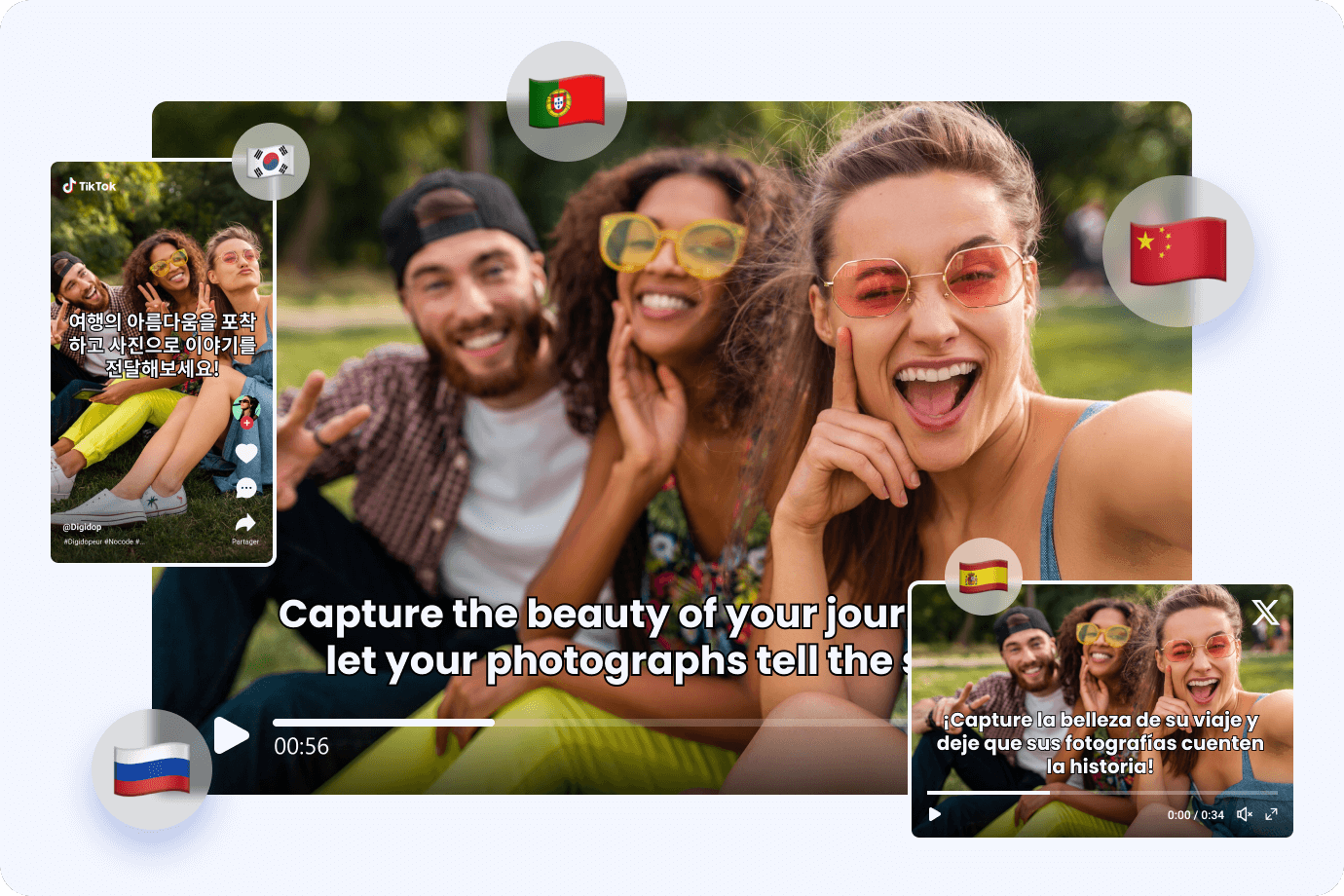
- Language learning enhancement. Use Virbo to translate Korean dramas or films with English subtitles. It aids in language immersion, pronunciation practice, and cultural understanding.
- Content creation and localization. Translate Korean YouTube videos or vlogs into English. It enables creators to expand their audience reach. You can also adapt your content for global viewership.
- Academic research and study. Translate Korean documentaries or educational videos into English to supplement academic research. Analyze cultural themes and enrich coursework with diverse perspectives.
- Business and professional use. Translate Korean corporate training materials or presentations into English. Encourage effective communication and collaboration among multinational teams and clients.
Pricing
Virbo offers a range of price plans to suit different needs. While the app does have a free version, its paid plans unlock a comprehensive suite of features (as of March 6, 2024):
- Monthly Plan: $9.9/month
- Yearly Plan - Essential: $19.9/year
- Yearly Plan - Pro: $199/year
The Monthly Plan includes 10 minutes of video credits per month. The Yearly Essential Plan provides 22 minutes per year. The Yearly Pro Plan offers 300 minutes annually. The Monthly Plan supports videos up to 2 minutes long. Meanwhile, both Yearly Plans allow videos of up to 5 minutes. All plans offer a maximum resolution of 1080p and unlimited time for AI scripts.
Part 3. Translate Korean Videos to English With Wondershare Virbo
With Wondershare Virbo, translating Korean videos to English has never been easier. Follow these simple steps to unlock a world of Korean entertainment:
- Step 1: Download and install Virbo on your device. You can also use the Virbo online tool if you can’t download the app for some reason. Launch Virbo. Log in with your Email, Wondershare, Google, Facebook, or Twitter account. Click the Video Translator button to start.

Get Started Online Free Download
- Step 2: Configure the video translator settings according to your preferences. Select the original language (Korean) and the translated language (English). Use the advanced settings mode to add subtitles and lip-sync. Afterward, click Translate Video.

- Step 3: After the translation process is complete, preview the video. Review the generated translation to ensure accuracy and quality. Check if the dubbing is in sync with the original video. When satisfied, save the video and share it with your audiences worldwide.

Conclusion
A Korean-to-English video translator is essential for enjoying Korean media content. Virbo’s AI-powered video translation feature offers effortless translation and enhances viewing experiences. The app ensures accurate subtitles and synchronized dubbing.
With Virbo, language barriers are taken care of. The app opens a lot of doors to the world of Korean entertainment. The ability to translate Korean to English videos allows you to immerse in their stories and culture. Explore the possibilities today and discover the full potential of Virbo.
There’s a rising demand for Korean to English-video translators. Over the years, K-dramas, K-pop, and Korean cinema gained immense popularity worldwide. Translation bridges linguistic gaps, allowing a broader audience to enjoy Korean content.
The article discusses the importance of translation in accessing Korean media. It will provide insights into how to translate Korean videos to English easily. Whether you’re a content creator or a fan, a handy app opens doors to a world of Korean entertainment. Read on to learn more.

Part 1. How To Look for a Reliable Korean-to-English Video Translator
Korean-to-English video translators are important in breaking down language barriers. They are valuable tools for helping cross-cultural communication. These tools use the power of AI to translate Korean audiovisual content into English. They enable a broader audience to access and enjoy Korean media.

Get Started Online Free Download
How Korean To English Video Translators Work
Korean-to-English video translators use AI algorithms to analyze spoken Korean language in video content. These translators transcribe Korean speech into text. The app then translates it into English subtitles. Depending on the app. They also provide real-time dubbing for an immersive viewing experience.
What To Look for in a Reliable Korean-to-English Video Translator
Translators serve as tools for non-Korean speakers to appreciate content originating from Korea. Here are the qualities you should look for if you want to translate the videos:
- Accuracy and translation quality
A reliable Korean-to-English video translator should have a high accuracy rate. Look for a tool that delivers precise translations. It should be able to capture the nuances of Korean language and culture. The app must be able to ensure grammatical correctness and natural fluency in English as well.
- Ease of use
Choose a translator with intuitive AI-powered features. A reliable app can streamline your translation process and save time. Features such as automatic speech recognition and intelligent subtitle sync enhance your efficiency.
- Features provided
Find a translator that offers a comprehensive range of features. It should include subtitle editing, real-time dubbing, and multi-language support.
- Compatibility and accessibility
Consider the compatibility of the translator across different devices. Cross-platform apps like Wondershare Virbo enable seamless translation experiences. It’s accessible across desktops, laptops, and mobile devices. Virbo allows you to translate Korean videos anytime, anywhere.
- Customer support and updates
Having a translator with reliable customer support and regular software updates is recommended. Responsive customer service ensures prompt help in case of technical issues or inquiries. Frequent updates guarantee continuous improvements in translation accuracy and performance as well.
- User reviews and ratings
Consult user reviews and ratings to gauge the reliability and effectiveness of the translator. Feedback from other users gives you ideas about the tool’s strengths and weaknesses. It helps you make an informed decision based on real-world experiences.
Part 2. What Makes Virbo the Top Translation Tool in 2024
Wondershare Virbo is a premier app for Korean video translations. It offers a wide range of features powered by advanced AI technology. Here’s why Virbo has earned its reputation as the top choice for content creators:

Get Started Online Free Download
- AI video translator supporting 20+ languages
Virbo’s AI video translator boasts support for over 20 languages. It can translate Korean to English videos, Spanish, French, German, Japanese, Chinese, and more. The extensive language support ensures versatility and accessibility for users worldwide. It enables seamless translation of diverse video content.
- Synchronized and captioned translations
With Virbo, translations are synchronized with the original video. Its seamless integration of subtitles or dubbing provides a natural viewing experience. Captions are timed to match the audio. It allows viewers to follow along and immerse themselves in the content without distractions.
- Lip-sync precision
Virbo’s AI tech ensures lip-sync precision in dubbing. It replicates the natural lip movements of speakers for authentic and realistic translation. The app maintains lip movements and audio if it’s dubbing a video in Korean translation into English or vice versa.
- Auto-generated scripts
Virbo streamlines the translation process by auto-generating scripts based on audio content. It saves a lot of time and effort for content creators. The feature eliminates the need for manual transcription. It allows you to focus on refining translations. You can enhance the quality of your video content in seconds.
- AI cloning voices
Taking advantage of AI cloning tech, Virbo can mimic voices. It has a remarkable accuracy, which is a plus. You can generate custom voiceovers or dubbing in your preferred language. It creates personalized translations that connect with your audience.
Virbo Use Cases
Here are the different use cases of Virbo for all your content creation needs:

- Language learning enhancement. Use Virbo to translate Korean dramas or films with English subtitles. It aids in language immersion, pronunciation practice, and cultural understanding.
- Content creation and localization. Translate Korean YouTube videos or vlogs into English. It enables creators to expand their audience reach. You can also adapt your content for global viewership.
- Academic research and study. Translate Korean documentaries or educational videos into English to supplement academic research. Analyze cultural themes and enrich coursework with diverse perspectives.
- Business and professional use. Translate Korean corporate training materials or presentations into English. Encourage effective communication and collaboration among multinational teams and clients.
Pricing
Virbo offers a range of price plans to suit different needs. While the app does have a free version, its paid plans unlock a comprehensive suite of features (as of March 6, 2024):
- Monthly Plan: $9.9/month
- Yearly Plan - Essential: $19.9/year
- Yearly Plan - Pro: $199/year
The Monthly Plan includes 10 minutes of video credits per month. The Yearly Essential Plan provides 22 minutes per year. The Yearly Pro Plan offers 300 minutes annually. The Monthly Plan supports videos up to 2 minutes long. Meanwhile, both Yearly Plans allow videos of up to 5 minutes. All plans offer a maximum resolution of 1080p and unlimited time for AI scripts.
Part 3. Translate Korean Videos to English With Wondershare Virbo
With Wondershare Virbo, translating Korean videos to English has never been easier. Follow these simple steps to unlock a world of Korean entertainment:
- Step 1: Download and install Virbo on your device. You can also use the Virbo online tool if you can’t download the app for some reason. Launch Virbo. Log in with your Email, Wondershare, Google, Facebook, or Twitter account. Click the Video Translator button to start.

Get Started Online Free Download
- Step 2: Configure the video translator settings according to your preferences. Select the original language (Korean) and the translated language (English). Use the advanced settings mode to add subtitles and lip-sync. Afterward, click Translate Video.

- Step 3: After the translation process is complete, preview the video. Review the generated translation to ensure accuracy and quality. Check if the dubbing is in sync with the original video. When satisfied, save the video and share it with your audiences worldwide.

Conclusion
A Korean-to-English video translator is essential for enjoying Korean media content. Virbo’s AI-powered video translation feature offers effortless translation and enhances viewing experiences. The app ensures accurate subtitles and synchronized dubbing.
With Virbo, language barriers are taken care of. The app opens a lot of doors to the world of Korean entertainment. The ability to translate Korean to English videos allows you to immerse in their stories and culture. Explore the possibilities today and discover the full potential of Virbo.
Elevate Your Content with the Best Free Video Translator Apps
Welcome to the world of content creation, where language should never be a barrier to connecting with your audience. In a world that thrives on diversity, the key to expanding your reach lies in breaking down linguistic barriers. This journey begins with harnessing the capabilities of the best free video translator apps. In this article, we delve into free video language translator apps catering to various needs, and pave the way for a more inclusive and globally connected audience.
Part 1: How Do Video Translator Apps Work?
Many free video translator apps are available today to help convey your message in different languages. These apps often act like magic tricks to assist people in understanding videos all over the world. For understanding its operation, it starts with speech recognition which is listened by the translation app. The words that are being said in the video are converted into text.
The app then utilizes machine translation powered by AI. This technology translates the text transcript from the source to your target language. As it reaches the end, the translated text appears as subtitles on the screen. You can follow the video and understand the content presented in it, even if it is not present in the native language.
Part 2: Benefits of Translating Video Through Best Video Translator
In the vast landscape of digital content, the ability to transcend language barriers is a powerful asset for content creators. This part of our exploration dives into the manifold benefits of translating videos through the best video translator apps, emphasizing how this strategic move can profoundly impact your reach and engagement.
1. Expanding Your Audience Reach
One of the primary advantages of leveraging the best video translator app free is the unparalleled ability to broaden your audience spectrum. By breaking language barriers, your content becomes accessible to viewers around the globe, fostering a diverse and engaged community.
2. Improving Engagement and Retention
A YouTube video translator app isn’t merely a tool for language conversion; it’s a catalyst for enhanced viewer engagement. Subtitles or voiceovers in a viewer’s native language not only make your content more comprehensible but also contribute to increased viewer retention, as audiences are more likely to invest time in content they can effortlessly understand.
3. Enhancing Accessibility
Beyond linguistic inclusivity, utilizing a free video translator app ensures your content is accessible to a wider audience, including those with hearing impairments. This commitment to accessibility strengthens your content’s appeal and contributes to the creation of a more inclusive online space.
4. Boosting SEO and Discoverability
The advantages of a video subtitle translator app extend beyond immediate viewer experience. Translating your video content can significantly boost its search engine optimization (SEO), making it more discoverable to users searching for content in various languages. This increased visibility can amplify your content’s impact across diverse platforms.
5. Facilitating Cross-Cultural Communication
A video voice translator app isn’t just a technological tool; it’s a bridge for effective cross-cultural communication. Breaking down language barriers fosters a sense of connection and understanding, creating a more engaged and loyal audience base that spans across different cultural backgrounds.
Part 3: Free Video Translator Apps to Translate Every Type of Video
In this section, we set forth on an exploration of the vast landscape of free video voice language translator apps. Our aim is to unveil a myriad of tools, each uniquely designed to cater to a spectrum of video translation needs. Join us as we navigate this diverse terrain, discovering the ideal solutions for every type of video translation requirement.
1. Wondershare Virbo
In the fast-paced world of digital content creation, the ability to communicate with a global audience is a game-changer. Virbo, a cutting-edge video language translator app, steps into this arena, offering content creators a dynamic platform to transcend linguistic barriers and connect with viewers worldwide. As we delve into Virbo, let’s explore its unique features, advantages, and considerations. It is readily available on both the Google Play Store and iOS App Store, ensuring accessibility for content creators across different platforms.
Get Started Online Download APP Now Free Download
Features:
- Whether you’re a seasoned creator or just starting, it’s user-friendly layout ensures a smooth and efficient experience.
- Its advanced speech recognition ensures accurate and nuanced translations, enhancing the audiovisual appeal of your content.
- It ensures that you can translate content dynamically as you create, providing instant feedback on how your video will resonate with a global audience.
Pros
- Its intuitive design ensures that creators of all levels can navigate the app seamlessly.
- Its extensive range of supported languages makes it a versatile tool for connecting with diverse audiences.
- Its commitment to user privacy ensures a secure environment for content creation and translation.
Cons
- It offers an offline mode; some features may be limited without an internet connection.
- For new users, the array of features may require some learning, but the intuitive design helps mitigate this.
How to Use Wondershare Virbo to Translate Videos
Wondershare Virbo makes it easy for users to translate their videos into any language, making the content accessible to a broader audience. Here is a quick guide on how to use this best video translator app to your advantage:
Step 1. Launch AI Video Translator on Virbo
To start translating your video using Virbo, install the app on your iOS or Android device. Once you launch Virbo on your smartphone, you must register using your Google or Apple ID. Choose a suitable option or use “Guest Login” from the top-right corner to continue without an ID. Next, launch the app and choose the “AI Video Translator” button from the homepage.

Step 2. Insert Video for Translation
You can follow the prompts present on the screen to upload your files. Keep in mind that the video resolution must be between 480x480 and 1920x1920. Virbo can only translate human voiceovers and cannot translate music or songs in the video, so files with background audio should be avoided.

Step 3. Specify Parameters and Translate Video
On the next window, select the original language of your video and the target language for translation. Virbo allows users to choose from multiple accents and voices. You can also tweak other options, such as keeping the subtitles after translation or keeping the original background music. Tap the “Translate” button, and once your video is generated, use the “Export” option to save it to your device.

Get Started Online Download APP Now Free Download
2. Google Translate
Standing as a beacon of versatility, Google Translate emerges as a leading video audio translator app. It supports a multitude of languages. It goes beyond traditional translation methods, offering real-time translation through the camera. Whether your content is spoken or written, it provides a user-friendly solution for diverse video translation requirements. Available on both Google Play Store and iOS, it ensures accessibility across different platforms, making it a convenient choice for users on various devices.

Features:
- It boasts an extensive language repertoire, supporting a vast array of languages, making it a versatile tool for global content translation.
- It excels in translating written text. Its text translation capabilities are robust and cover a wide range of linguistic nuances.
- A standout feature is the real-time camera translation, enabling users to translate text in images or videos instantly through their device’s camera.
Pros
- It has a user-friendly interface, making it accessible for users with varying levels of technological expertise.
- It eliminates financial barriers, allowing a broad user base to benefit from its language translation features.
- It regularly updates and improves its translation algorithms.
Cons
- It may still face challenges in accurately translating complex or context-specific phrases.
- Its certain features depend on an internet connection, limiting functionality in offline scenarios.
3. Microsoft Translator
In the world of text and voice translation, Microsoft Translator takes the spotlight. This free and accessible tool caters to content creators seeking seamless translation for spoken content in their videos. Its user-friendly interface and wide language support make it a go-to choice for creators of all levels. Available on both Google Play Store and iOS, Microsoft Translator offers a versatile solution for on-the-go translation needs.

Features:
- It boasts an extensive language portfolio, covering a diverse range of languages to facilitate global communication.
- It excels in text and voice translations, providing users with flexibility in how they choose to communicate across language barriers.
- It is designed with a user-friendly interface, ensuring accessibility for users with varying levels of technical expertise.
Pros
- It is recognized for its accurate speech recognition.
- It allows users to translate content directly within familiar Office tools.
- It supports collaborative translation efforts, enabling multiple users to work together on translating content.
Cons
- It may face challenges in achieving the same level of fluency and nuance in translations for all supported languages.
- Some advanced features may depend on a consistent internet connection.
4. SayHi
Venturing into the realm of voice translation, SayHi captures attention with its real-time translation capabilities. Ideal for creators looking for video voice translator app to add voiceovers or dubbing in different languages, it provides a seamless experience for translating spoken words, enriching the audiovisual dimension of your videos. Find it on iOS and Google Play Store for an accessible and versatile translation experience.

Features:
- It specializes in real-time voice translation, allowing users to engage in live conversations and create dynamic multilingual content effortlessly.
- It supports a wide array of languages, enabling users to translate spoken words seamlessly across diverse linguistic contexts.
- It features a user-friendly interface, making it accessible for users of various language proficiency levels and technical expertise.
Pros
- It offers an offline mode, allowing users to download language packs and perform translations without the need for a continuous internet connection.
- It includes a phrasebook feature, enabling users to store commonly used phrases for quick and easy access during conversations.
- Users have the ability to define and customize dialects, enhancing the precision of translations for specific regional or contextual language nuances.
Cons
- It may face challenges in accurately capturing the nuanced complexities of certain languages and dialects.
- Some advanced features may depend on an internet connection, limiting functionality in offline scenarios.
5. iTranslate Converse
iTranslate Converse takes real-time translation to a new level with its intuitive design resembling a messaging app. This innovative approach allows users to engage in natural conversations that are instantly translated. Supporting a plethora of languages, it is a dynamic tool for spontaneous communication, making it a go-to for those seeking seamless interaction. Available on iOS and the Google App Store, it’s the go-to choice for seamless, spontaneous communication.

Features:
- It resembles a messaging app, offering a familiar and user-friendly environment for communication.
- It facilitates natural and fluid conversations with instant translation, enhancing the user experience.
- This app goes beyond text, allowing users to send voice messages that are instantly translated, adding a dynamic and personal touch to conversations.
Pros
- It excels in real-time conversation mode, allowing users to communicate naturally without interruptions.
- The app’s design enhances usability.
- Ideal for spontaneous communication.
Cons
- Some advanced features may require a subscription.
- Like many translation apps, accuracy may be influenced by speech clarity and ambient noise.
6. Papago
Hailing from South Korea, Papago is an acclaimed translation app known for its accuracy and efficiency. Available on the Google App Store, it provides real-time text and voice translation, breaking down language barriers in everyday and business settings. Papago’s commitment to precision makes it a reliable companion for seamless global communication.

Features:
- It accurately captures spoken language and converts it into text, providing users with a seamless and efficient way to communicate across language barriers.
- It is known for its accuracy and efficiency in translating both text and voice.
- It provides a comprehensive range of supported languages, catering to diverse user needs.
Pros
- It incorporates human expertise, adding a nuanced touch to translations that go beyond literal meaning.
- It brings a unique perspective and precision to its translations.
- It offers offline functionality.
Cons
- It may be less known globally compared to some other translation apps.
- The interface may be perceived as more complex for users seeking a simpler design.
Bonus Part. FAQs About Video Translator Apps
- Can free video translator apps be used offline?
While many video translator apps are available today, only a few free apps can work offline. Some free options claim offline video translation, but their accuracy and functionalities might be restricted. Unlike the more comprehensive online selection, free versions may restrict offline translation to a few popular languages. In addition, real-time translation of live videos often requires an internet connection to process them.
- Can free video translator apps handle all types of videos?
Free video translator apps can usually handle a good variety of videos. However, a few limitations may arise at times. Most free apps will likely work with popular video formats like MP4, and some might support fewer common formats. Similarly, free apps may have restrictions on video lengths. They may also struggle with videos with heavy background noise or multiple speakers.
- Are free video translator apps accurate?
The accuracy of free video translator apps is a mixed bag. Usually, accuracy factors depend on the machine-learning abilities of individual apps. Free apps can translate basic sentences with clear audio reasonably well. You can likely grasp the overall idea of a video in a common language with a free translator app.
- How do you translate a video into English?
You can try one of the many video translator apps available today to translate a video into English. In all honesty, the most reliable tool for video translation is Wondershare Virbo. It has all the tools you may need to convert a language into English. Virbo is a quick and easy way to accurately translate videos to and from any language in a few clicks.
Get Started Online Download APP Now Free Download
Conclusion
In the world of digital content creation, breaking language barriers is the key to global engagement. Video translation apps serve as invaluable tools for content creators, enabling them to connect with diverse audiences. From exploring the benefits of the best video translator app to introducing free options like Wondershare Virbo, Google Translate, Microsoft Translator, Subtitle Edit, SayHi, and Amara, this journey has showcased the vast landscape of possibilities.
Get Started Online Download APP Now Free Download
Features:
- Whether you’re a seasoned creator or just starting, it’s user-friendly layout ensures a smooth and efficient experience.
- Its advanced speech recognition ensures accurate and nuanced translations, enhancing the audiovisual appeal of your content.
- It ensures that you can translate content dynamically as you create, providing instant feedback on how your video will resonate with a global audience.
Pros
- Its intuitive design ensures that creators of all levels can navigate the app seamlessly.
- Its extensive range of supported languages makes it a versatile tool for connecting with diverse audiences.
- Its commitment to user privacy ensures a secure environment for content creation and translation.
Cons
- It offers an offline mode; some features may be limited without an internet connection.
- For new users, the array of features may require some learning, but the intuitive design helps mitigate this.
How to Use Wondershare Virbo to Translate Videos
Wondershare Virbo makes it easy for users to translate their videos into any language, making the content accessible to a broader audience. Here is a quick guide on how to use this best video translator app to your advantage:
Step 1. Launch AI Video Translator on Virbo
To start translating your video using Virbo, install the app on your iOS or Android device. Once you launch Virbo on your smartphone, you must register using your Google or Apple ID. Choose a suitable option or use “Guest Login” from the top-right corner to continue without an ID. Next, launch the app and choose the “AI Video Translator” button from the homepage.

Step 2. Insert Video for Translation
You can follow the prompts present on the screen to upload your files. Keep in mind that the video resolution must be between 480x480 and 1920x1920. Virbo can only translate human voiceovers and cannot translate music or songs in the video, so files with background audio should be avoided.

Step 3. Specify Parameters and Translate Video
On the next window, select the original language of your video and the target language for translation. Virbo allows users to choose from multiple accents and voices. You can also tweak other options, such as keeping the subtitles after translation or keeping the original background music. Tap the “Translate” button, and once your video is generated, use the “Export” option to save it to your device.

Get Started Online Download APP Now Free Download
2. Google Translate
Standing as a beacon of versatility, Google Translate emerges as a leading video audio translator app. It supports a multitude of languages. It goes beyond traditional translation methods, offering real-time translation through the camera. Whether your content is spoken or written, it provides a user-friendly solution for diverse video translation requirements. Available on both Google Play Store and iOS, it ensures accessibility across different platforms, making it a convenient choice for users on various devices.

Features:
- It boasts an extensive language repertoire, supporting a vast array of languages, making it a versatile tool for global content translation.
- It excels in translating written text. Its text translation capabilities are robust and cover a wide range of linguistic nuances.
- A standout feature is the real-time camera translation, enabling users to translate text in images or videos instantly through their device’s camera.
Pros
- It has a user-friendly interface, making it accessible for users with varying levels of technological expertise.
- It eliminates financial barriers, allowing a broad user base to benefit from its language translation features.
- It regularly updates and improves its translation algorithms.
Cons
- It may still face challenges in accurately translating complex or context-specific phrases.
- Its certain features depend on an internet connection, limiting functionality in offline scenarios.
3. Microsoft Translator
In the world of text and voice translation, Microsoft Translator takes the spotlight. This free and accessible tool caters to content creators seeking seamless translation for spoken content in their videos. Its user-friendly interface and wide language support make it a go-to choice for creators of all levels. Available on both Google Play Store and iOS, Microsoft Translator offers a versatile solution for on-the-go translation needs.

Features:
- It boasts an extensive language portfolio, covering a diverse range of languages to facilitate global communication.
- It excels in text and voice translations, providing users with flexibility in how they choose to communicate across language barriers.
- It is designed with a user-friendly interface, ensuring accessibility for users with varying levels of technical expertise.
Pros
- It is recognized for its accurate speech recognition.
- It allows users to translate content directly within familiar Office tools.
- It supports collaborative translation efforts, enabling multiple users to work together on translating content.
Cons
- It may face challenges in achieving the same level of fluency and nuance in translations for all supported languages.
- Some advanced features may depend on a consistent internet connection.
4. SayHi
Venturing into the realm of voice translation, SayHi captures attention with its real-time translation capabilities. Ideal for creators looking for video voice translator app to add voiceovers or dubbing in different languages, it provides a seamless experience for translating spoken words, enriching the audiovisual dimension of your videos. Find it on iOS and Google Play Store for an accessible and versatile translation experience.

Features:
- It specializes in real-time voice translation, allowing users to engage in live conversations and create dynamic multilingual content effortlessly.
- It supports a wide array of languages, enabling users to translate spoken words seamlessly across diverse linguistic contexts.
- It features a user-friendly interface, making it accessible for users of various language proficiency levels and technical expertise.
Pros
- It offers an offline mode, allowing users to download language packs and perform translations without the need for a continuous internet connection.
- It includes a phrasebook feature, enabling users to store commonly used phrases for quick and easy access during conversations.
- Users have the ability to define and customize dialects, enhancing the precision of translations for specific regional or contextual language nuances.
Cons
- It may face challenges in accurately capturing the nuanced complexities of certain languages and dialects.
- Some advanced features may depend on an internet connection, limiting functionality in offline scenarios.
5. iTranslate Converse
iTranslate Converse takes real-time translation to a new level with its intuitive design resembling a messaging app. This innovative approach allows users to engage in natural conversations that are instantly translated. Supporting a plethora of languages, it is a dynamic tool for spontaneous communication, making it a go-to for those seeking seamless interaction. Available on iOS and the Google App Store, it’s the go-to choice for seamless, spontaneous communication.

Features:
- It resembles a messaging app, offering a familiar and user-friendly environment for communication.
- It facilitates natural and fluid conversations with instant translation, enhancing the user experience.
- This app goes beyond text, allowing users to send voice messages that are instantly translated, adding a dynamic and personal touch to conversations.
Pros
- It excels in real-time conversation mode, allowing users to communicate naturally without interruptions.
- The app’s design enhances usability.
- Ideal for spontaneous communication.
Cons
- Some advanced features may require a subscription.
- Like many translation apps, accuracy may be influenced by speech clarity and ambient noise.
6. Papago
Hailing from South Korea, Papago is an acclaimed translation app known for its accuracy and efficiency. Available on the Google App Store, it provides real-time text and voice translation, breaking down language barriers in everyday and business settings. Papago’s commitment to precision makes it a reliable companion for seamless global communication.

Features:
- It accurately captures spoken language and converts it into text, providing users with a seamless and efficient way to communicate across language barriers.
- It is known for its accuracy and efficiency in translating both text and voice.
- It provides a comprehensive range of supported languages, catering to diverse user needs.
Pros
- It incorporates human expertise, adding a nuanced touch to translations that go beyond literal meaning.
- It brings a unique perspective and precision to its translations.
- It offers offline functionality.
Cons
- It may be less known globally compared to some other translation apps.
- The interface may be perceived as more complex for users seeking a simpler design.
Bonus Part. FAQs About Video Translator Apps
- Can free video translator apps be used offline?
While many video translator apps are available today, only a few free apps can work offline. Some free options claim offline video translation, but their accuracy and functionalities might be restricted. Unlike the more comprehensive online selection, free versions may restrict offline translation to a few popular languages. In addition, real-time translation of live videos often requires an internet connection to process them.
- Can free video translator apps handle all types of videos?
Free video translator apps can usually handle a good variety of videos. However, a few limitations may arise at times. Most free apps will likely work with popular video formats like MP4, and some might support fewer common formats. Similarly, free apps may have restrictions on video lengths. They may also struggle with videos with heavy background noise or multiple speakers.
- Are free video translator apps accurate?
The accuracy of free video translator apps is a mixed bag. Usually, accuracy factors depend on the machine-learning abilities of individual apps. Free apps can translate basic sentences with clear audio reasonably well. You can likely grasp the overall idea of a video in a common language with a free translator app.
- How do you translate a video into English?
You can try one of the many video translator apps available today to translate a video into English. In all honesty, the most reliable tool for video translation is Wondershare Virbo. It has all the tools you may need to convert a language into English. Virbo is a quick and easy way to accurately translate videos to and from any language in a few clicks.
Get Started Online Download APP Now Free Download
Conclusion
In the world of digital content creation, breaking language barriers is the key to global engagement. Video translation apps serve as invaluable tools for content creators, enabling them to connect with diverse audiences. From exploring the benefits of the best video translator app to introducing free options like Wondershare Virbo, Google Translate, Microsoft Translator, Subtitle Edit, SayHi, and Amara, this journey has showcased the vast landscape of possibilities.
Get Started Online Download APP Now Free Download
How To Translate Video From Japanese to English Online?
Let’s say you’re a business owner or a content creator in Japan. If you want to broaden your horizons, you may need to translate videos from Japanese to English. This is because English is spoken globally. You can sell more, share knowledge, and connect with English speakers worldwide.
For streaming platforms, turning Japanese content into English is a ticket to reaching audiences all over the globe. And businesses using Japanese tech might need translated training videos for their remote workers.
Seeing this growing need, it’s clear you need effective video translation solutions. So, we’ve created a guide to help you choose the best method for each step, including using AI. Finding the right way to translate videos is important, so keep reading!

Part I. Completed Process To Translate Videos From Japanese to English
When you want to translate a video from Japanese to English, you can follow some general steps, no matter how you decide to do it. Let’s break down each step for you:
- Step 1: Video Transcription
Before you can translate, you need to understand what’s being said. So, the initial step is to do a video transcription. You can either hire professionals or use a Japanese-to-English video translator app to convert the spoken language to text.
Transcription captures all the Japanese dialogue, ensuring the English translation is spot-on. Having the text file lets you edit it, like shortening sentences or adjusting cultural references. This results in a smoother and more natural English video for you.
- Step 2: Translation
Once you have the transcript, you can translate the Japanese text into English. A good translation ensures the original message is accurately conveyed in the new language. It avoids any misunderstandings or misinterpretations for your English viewers. You have two options to do it. Both have strengths and weaknesses, so let’s see which suits your needs best.
- Professional Human Translation Services
When you want to translate a video from Japanese to English, a pro can make the sentences sound right for your audience. These professionals tweak the tone to be natural and engaging. If you go to translation agencies, they make sure the work is top-notch by going through strict editing and reviewing. However, human translation services cost more and take a bit more time than machine translation tools.
- Machine Translation Tools
Machine translation tools are fast and affordable. They can be a good option for short, simple videos where perfect accuracy isn’t critical. But it often struggles with complex language, cultural references, and humor.
- Step 3: Timing and Implementation
Let’s talk about making the Japanese to English video translation seamless. After translating, you want the words to match the original rhythm and pace of the speaker in the video. It keeps things feeling natural and engaging for you, the viewer. Plus, speakers use non-verbal cues like jokes, emotions, and pauses. Matching the translated text with these visual cues keeps the video’s meaning and impact intact.
How to do it? Professional workflows often use timecode, which gives each video frame a unique timestamp. It ensures super precise subtitle placement for that perfect synchronization. Some video editing tools even have “waveforms” to help visually line up subtitles with the spoken parts.

Here are several ways to add the translated Japanese text to your video:
- Subtitles
Subtitles are like on-screen translators for you. They show the English dialogue while the original Japanese audio goes on. It helps you understand if you get the visuals but not the language. The focus is on getting the main point across and sometimes making the sentences shorter for easier reading.
- Closed Captions
Like subtitles, closed captions (CC) are words shown on the screen. They go beyond spoken words, covering all the sounds you hear, like dialogue, music, and even background noises. The main goal is to help you, especially if you’re deaf or struggle with hearing. So, if you’re aiming for videos everyone can enjoy, try a video translator from Japanese to English with CC capabilities.
- Dubbing
Dubbing is a more intricate process where the original Japanese audio track is completely replaced. Voice actors step in to record the translated script in English. They try to sync up their words with the lip movements of the characters on screen. It makes it seem like the characters speak English right from the start, giving you a more immersive viewing experience.
- Voiceover
In this method, a narrator reads the translated script in English over the original Japanese audio. It’s often used in documentaries or educational videos when you need more info beyond just the dialogue.
- Step 4: Final Review and Approval
Alright, so you’re at the last step now. You’re giving the translated video a good check to ensure everything’s spot-on – accurate, consistent, and top-notch quality. It means looking out for any problems in the translation, timing, or how you choose to do it. Once you give the thumbs up to the final version, you’ve got a smooth and effective English video ready for your audience.
You might find the previous steps tedious and time-consuming. But what if you could translate your video from Japanese to English in minutes? That way, you could reach new markets and expand your influence faster. AI video translators like Wondershare Virbo can help you spread your work, passions, and stories to a global audience. Read on to learn more.
Part II. Virbo: Realistic AI Japanese to English Video Translator
You’re excited about your new product, but your explainer video feels like it’s only speaking to half the world. You know the potential exists, but the language barrier holds you back. Or perhaps you’ve captured stunning footage from your recent trip to Kyoto, but sharing it with your followers feels like a lost cause.
Here’s the deal: you don’t have to stick to a small crowd.

Get Started Online Free Download
Virbo uses the latest AI tech to automatically translate, dub voice, and add synced subtitles to your Japanese video. This app is simple to use and can translate video content into over 20 languages. Virbo translates Japanese to English videos in a few minutes – all free for videos under 2 minutes!
Here’s what makes Virbo stand out:
- Precise Lip-sync: Say goodbye to awkward, out-of-sync translations. Virbo AI video translator ensures the translated dialogue seamlessly matches the speaker’s lip movements and facial expressions, creating a natural and engaging experience (still in beta, but getting better every day!).
- AI Cloning Voices: Add engagement with Virbo’s AI-cloned voices that capture the essence of human speech. Choose from a range of natural-sounding voices that express the right emotions and add personality to your content.
- Soundtrack Reserved: Don’t lose the original soundtrack that sets the mood. Virbo allows you to keep it intact, enhancing its impact even in different languages.
- Versatile Compatibility: Virbo works across various platforms, including Windows, iOS, and Android. You can even use it online for ultimate flexibility.
- Affordable Excellence: Experience the power of AI video translation without breaking the bank. Virbo offers high-quality solutions at affordable prices, making them accessible to everyone.
Part III. How To Translate Japanese to English Video Using Virbo Automatically
Using Virbo AI video translator can help you be more productive. Here’s how to translate a video in Japanese to English online for free:
- Step 1: Go to Virbo AI video translator online from your browser for quick access. You can also download the app for your desktop. Once you’ve chosen your access point, sign in using your existing Google, Facebook, email, Apple, or Twitter account.
Get Started Online Free Download
- Step 2: Choose and upload your Japanese video file from your local storage. Ensure the video is between 10 seconds to 5 minutes long and in MP4 or MOV format, up to 500 MB for optimal processing.
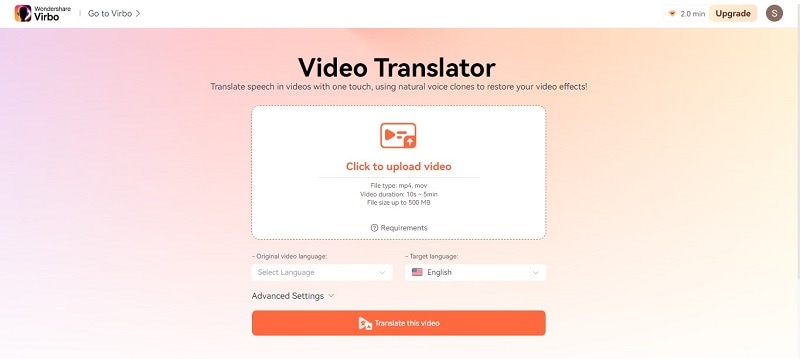
- Step 3: Specify Japanese as the Original video language and English as the desired Target language.
- Step 4: Virbo offers Advanced Settings to customize the translated view result. Toggle on the Lip-sync, Subtitle, and Proofread video script switches to enable them when needed.
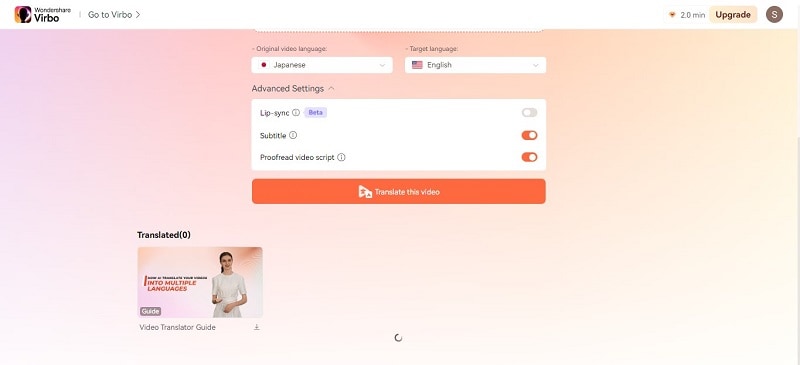
- Step 5: Click Translate this video to start the translation process once everything is set.
- Step 6: Wait a few moments while Virbo performs video transcription. Review the text and edit if needed.
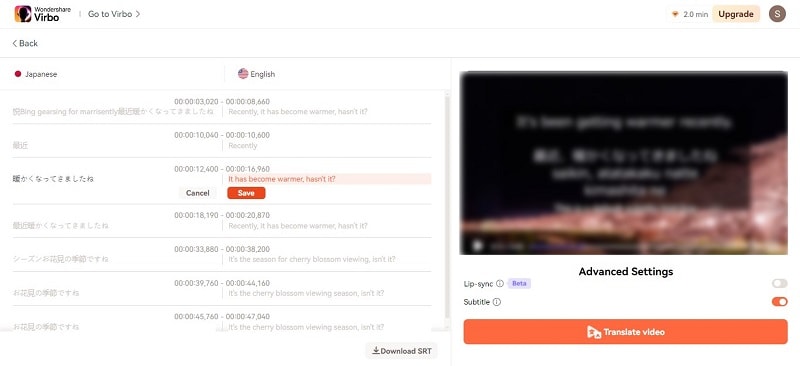
- Step 7: Click Translate video to proceed, then the video will go to the queue.
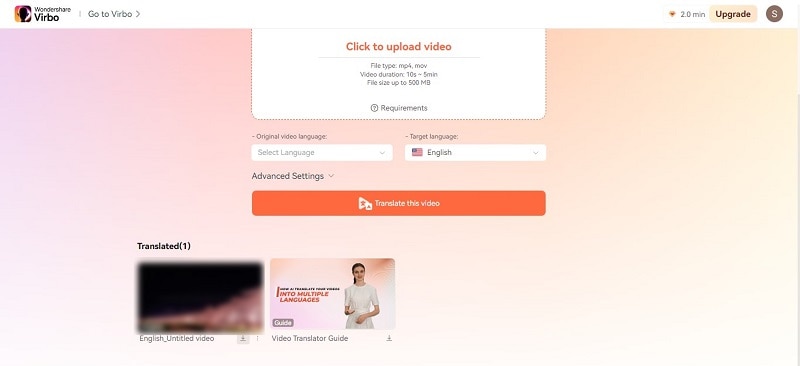
- Step 8: After completion, you can preview the translated video before downloading the final English version.
Part IV. How To Achieve the Best Video Translation Results?
You can’t always translate a video from Japanese to English without a few difficulties. Here are some ways to make the process easier for you:
Divide the Script Into Manageable Chunks
Break down the script into smaller sections like sentences, phrases, or even shorter segments depending on the video’s pace and complexity. It allows for more precise timing adjustments later.
Use a “Shadowing” Technique
As you watch the video, read the translated text out loud. Adjust the subtitle timing to match how you naturally speak. Doing this makes the flow feel more natural for you and the viewers.
Test and Refine
Now that you’ve set the timing for the subtitles, it’s time to put them to the test with your target audience. This step is important because it helps you catch any timing problems, awkward phrasing, or cultural differences that might have slipped through during editing.
Listen to what your audience says, and then use that feedback to tweak the subtitles. Your goal is to make sure they’re clear, short, and match the audience’s culture.
AI for Pre-Translation Tasks
Take advantage of AI tools for speech-to-text conversion and automatic subtitle generation. It can save time, but always proofread for accuracy and natural flow.
File Compatibility
Ensure your chosen translation service or tool supports the format of your video file. The common formats include MP4, MOV, and AVI.
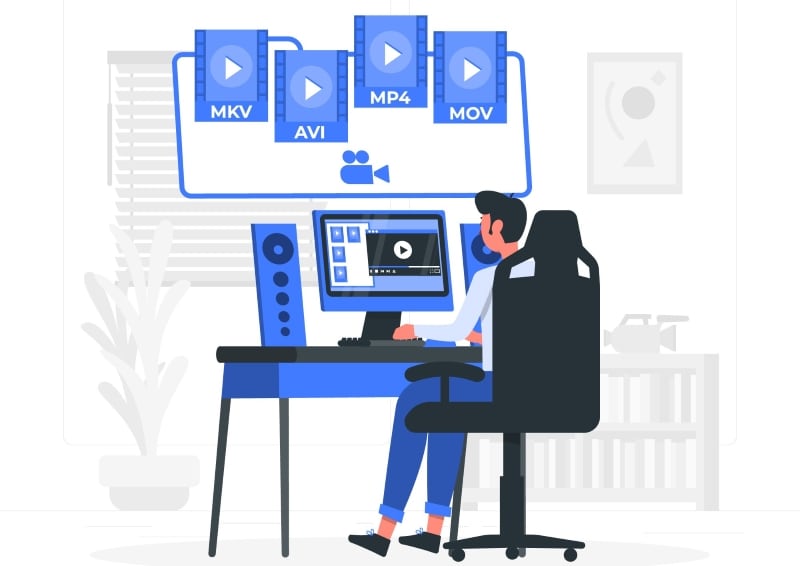
Conclusion
So you’ve seen how easy it can be to translate a video from Japanese to English. It’s up to you whether you will ask for the help of human translators, video editors, or AI video translators.
As you know, Virbo goes beyond being a basic Japanese to English video translator and converter. It takes the complexity out of translation, offering seamless and accurate results.
But remember, even the best AI translation can benefit from a human touch. Don’t be afraid to experiment and refine your translated video for the best outcome. With a little effort, you can bridge the language barrier and share your Japanese video content with the world.
Let’s say you’re a business owner or a content creator in Japan. If you want to broaden your horizons, you may need to translate videos from Japanese to English. This is because English is spoken globally. You can sell more, share knowledge, and connect with English speakers worldwide.
For streaming platforms, turning Japanese content into English is a ticket to reaching audiences all over the globe. And businesses using Japanese tech might need translated training videos for their remote workers.
Seeing this growing need, it’s clear you need effective video translation solutions. So, we’ve created a guide to help you choose the best method for each step, including using AI. Finding the right way to translate videos is important, so keep reading!

Part I. Completed Process To Translate Videos From Japanese to English
When you want to translate a video from Japanese to English, you can follow some general steps, no matter how you decide to do it. Let’s break down each step for you:
- Step 1: Video Transcription
Before you can translate, you need to understand what’s being said. So, the initial step is to do a video transcription. You can either hire professionals or use a Japanese-to-English video translator app to convert the spoken language to text.
Transcription captures all the Japanese dialogue, ensuring the English translation is spot-on. Having the text file lets you edit it, like shortening sentences or adjusting cultural references. This results in a smoother and more natural English video for you.
- Step 2: Translation
Once you have the transcript, you can translate the Japanese text into English. A good translation ensures the original message is accurately conveyed in the new language. It avoids any misunderstandings or misinterpretations for your English viewers. You have two options to do it. Both have strengths and weaknesses, so let’s see which suits your needs best.
- Professional Human Translation Services
When you want to translate a video from Japanese to English, a pro can make the sentences sound right for your audience. These professionals tweak the tone to be natural and engaging. If you go to translation agencies, they make sure the work is top-notch by going through strict editing and reviewing. However, human translation services cost more and take a bit more time than machine translation tools.
- Machine Translation Tools
Machine translation tools are fast and affordable. They can be a good option for short, simple videos where perfect accuracy isn’t critical. But it often struggles with complex language, cultural references, and humor.
- Step 3: Timing and Implementation
Let’s talk about making the Japanese to English video translation seamless. After translating, you want the words to match the original rhythm and pace of the speaker in the video. It keeps things feeling natural and engaging for you, the viewer. Plus, speakers use non-verbal cues like jokes, emotions, and pauses. Matching the translated text with these visual cues keeps the video’s meaning and impact intact.
How to do it? Professional workflows often use timecode, which gives each video frame a unique timestamp. It ensures super precise subtitle placement for that perfect synchronization. Some video editing tools even have “waveforms” to help visually line up subtitles with the spoken parts.

Here are several ways to add the translated Japanese text to your video:
- Subtitles
Subtitles are like on-screen translators for you. They show the English dialogue while the original Japanese audio goes on. It helps you understand if you get the visuals but not the language. The focus is on getting the main point across and sometimes making the sentences shorter for easier reading.
- Closed Captions
Like subtitles, closed captions (CC) are words shown on the screen. They go beyond spoken words, covering all the sounds you hear, like dialogue, music, and even background noises. The main goal is to help you, especially if you’re deaf or struggle with hearing. So, if you’re aiming for videos everyone can enjoy, try a video translator from Japanese to English with CC capabilities.
- Dubbing
Dubbing is a more intricate process where the original Japanese audio track is completely replaced. Voice actors step in to record the translated script in English. They try to sync up their words with the lip movements of the characters on screen. It makes it seem like the characters speak English right from the start, giving you a more immersive viewing experience.
- Voiceover
In this method, a narrator reads the translated script in English over the original Japanese audio. It’s often used in documentaries or educational videos when you need more info beyond just the dialogue.
- Step 4: Final Review and Approval
Alright, so you’re at the last step now. You’re giving the translated video a good check to ensure everything’s spot-on – accurate, consistent, and top-notch quality. It means looking out for any problems in the translation, timing, or how you choose to do it. Once you give the thumbs up to the final version, you’ve got a smooth and effective English video ready for your audience.
You might find the previous steps tedious and time-consuming. But what if you could translate your video from Japanese to English in minutes? That way, you could reach new markets and expand your influence faster. AI video translators like Wondershare Virbo can help you spread your work, passions, and stories to a global audience. Read on to learn more.
Part II. Virbo: Realistic AI Japanese to English Video Translator
You’re excited about your new product, but your explainer video feels like it’s only speaking to half the world. You know the potential exists, but the language barrier holds you back. Or perhaps you’ve captured stunning footage from your recent trip to Kyoto, but sharing it with your followers feels like a lost cause.
Here’s the deal: you don’t have to stick to a small crowd.

Get Started Online Free Download
Virbo uses the latest AI tech to automatically translate, dub voice, and add synced subtitles to your Japanese video. This app is simple to use and can translate video content into over 20 languages. Virbo translates Japanese to English videos in a few minutes – all free for videos under 2 minutes!
Here’s what makes Virbo stand out:
- Precise Lip-sync: Say goodbye to awkward, out-of-sync translations. Virbo AI video translator ensures the translated dialogue seamlessly matches the speaker’s lip movements and facial expressions, creating a natural and engaging experience (still in beta, but getting better every day!).
- AI Cloning Voices: Add engagement with Virbo’s AI-cloned voices that capture the essence of human speech. Choose from a range of natural-sounding voices that express the right emotions and add personality to your content.
- Soundtrack Reserved: Don’t lose the original soundtrack that sets the mood. Virbo allows you to keep it intact, enhancing its impact even in different languages.
- Versatile Compatibility: Virbo works across various platforms, including Windows, iOS, and Android. You can even use it online for ultimate flexibility.
- Affordable Excellence: Experience the power of AI video translation without breaking the bank. Virbo offers high-quality solutions at affordable prices, making them accessible to everyone.
Part III. How To Translate Japanese to English Video Using Virbo Automatically
Using Virbo AI video translator can help you be more productive. Here’s how to translate a video in Japanese to English online for free:
- Step 1: Go to Virbo AI video translator online from your browser for quick access. You can also download the app for your desktop. Once you’ve chosen your access point, sign in using your existing Google, Facebook, email, Apple, or Twitter account.
Get Started Online Free Download
- Step 2: Choose and upload your Japanese video file from your local storage. Ensure the video is between 10 seconds to 5 minutes long and in MP4 or MOV format, up to 500 MB for optimal processing.

- Step 3: Specify Japanese as the Original video language and English as the desired Target language.
- Step 4: Virbo offers Advanced Settings to customize the translated view result. Toggle on the Lip-sync, Subtitle, and Proofread video script switches to enable them when needed.

- Step 5: Click Translate this video to start the translation process once everything is set.
- Step 6: Wait a few moments while Virbo performs video transcription. Review the text and edit if needed.

- Step 7: Click Translate video to proceed, then the video will go to the queue.

- Step 8: After completion, you can preview the translated video before downloading the final English version.
Part IV. How To Achieve the Best Video Translation Results?
You can’t always translate a video from Japanese to English without a few difficulties. Here are some ways to make the process easier for you:
Divide the Script Into Manageable Chunks
Break down the script into smaller sections like sentences, phrases, or even shorter segments depending on the video’s pace and complexity. It allows for more precise timing adjustments later.
Use a “Shadowing” Technique
As you watch the video, read the translated text out loud. Adjust the subtitle timing to match how you naturally speak. Doing this makes the flow feel more natural for you and the viewers.
Test and Refine
Now that you’ve set the timing for the subtitles, it’s time to put them to the test with your target audience. This step is important because it helps you catch any timing problems, awkward phrasing, or cultural differences that might have slipped through during editing.
Listen to what your audience says, and then use that feedback to tweak the subtitles. Your goal is to make sure they’re clear, short, and match the audience’s culture.
AI for Pre-Translation Tasks
Take advantage of AI tools for speech-to-text conversion and automatic subtitle generation. It can save time, but always proofread for accuracy and natural flow.
File Compatibility
Ensure your chosen translation service or tool supports the format of your video file. The common formats include MP4, MOV, and AVI.

Conclusion
So you’ve seen how easy it can be to translate a video from Japanese to English. It’s up to you whether you will ask for the help of human translators, video editors, or AI video translators.
As you know, Virbo goes beyond being a basic Japanese to English video translator and converter. It takes the complexity out of translation, offering seamless and accurate results.
But remember, even the best AI translation can benefit from a human touch. Don’t be afraid to experiment and refine your translated video for the best outcome. With a little effort, you can bridge the language barrier and share your Japanese video content with the world.
A Comprehensive Guide to Video and Subtitle Translation with Veed.io
If you are a multilingual content creator, having a tool like Veed in your arsenal can be pretty useful. It can quickly and accurately translate your videos online. Such translated content can allow you to reach a much wider audience and engage with them in a better way. It’s a powerful tool that can simplify the process of adding subtitles, transcriptions, and translations to your video content. In this article, we will explain how you can utilize Veed io translate feature to stay on top of your game.
Part 1. Veed Translate: Unlocking Language Diversity
Translating videos and adding captions to your YouTube videos makes your content more accessible. You can make content suitable for more social platforms and engage even more audiences. Below are some useful tips for unlocking language diversity with the Veed video translate feature.
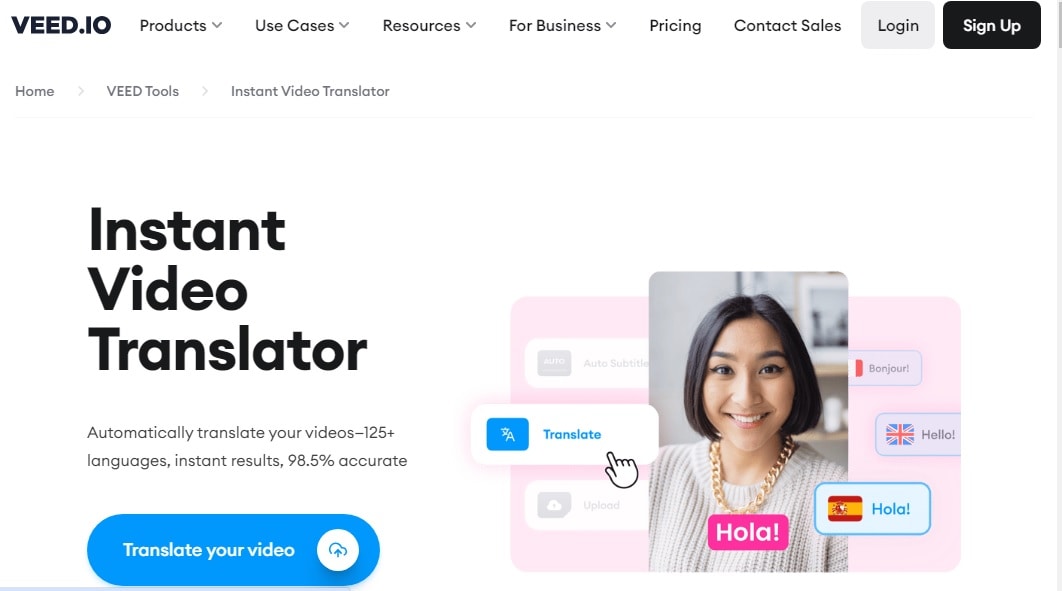
Seamless integration with YouTube and other social media platforms
Veed supports seamless integration with all popular social media platforms. With this tool, you can import your videos from YouTube for quick translation, share your translated video directly to Facebook, optimize your video content for TikTok, and do so much more. This ensures you can optimize your content for maximum social media engagement and reach a wider audience.
Contextually relevant and accurate translations
Veed has a fantastic 98.5% accuracy rate when it comes to translations. This means Veed is actually a great alternative to tools like Google Translate that don’t always provide contextually relevant output. It automatically transcribes the audio in your videos into simple text. Afterwards, it synchronizes the generated text with your videos, ensuring accurate and well-timed translations.
Fantastic Editing Tools
Veed gives you complete creative control over the type of content you want to produce and how. It offers a range of editing tools to enhance your video creation process. For instance, it lets you change and customize the font style. You can use fun fonts, spacing, size, colors, etc. You can also add animations and visuals, incorporate templates and do so much more.
Multi-language support and translation service
Veed supports multiple languages. To be more specific, Veed translations are available in 125+ different languages of the world. This makes it easy for you to reach a global audience by creating content that resonates with a diverse audience.
Professional quality output with easy sharing options
Once you are done with your video, you can export it in multiple different formats. For instance, it supports SRT and VTT subtitle files. You can export the text as an SRT file for easy sharing and upload on other platforms, including social media, websites and podcasts etc. There’s also a screen recording option which lets you create pro-grade videos with the help of voiceovers and CC feature.
Generate Engaging
AI Video in Minutes!
Easily convert text into professional spokesperson videos in over 120+ voices & languages in minutes.
Generate AI Video Free Generate AI Video Now
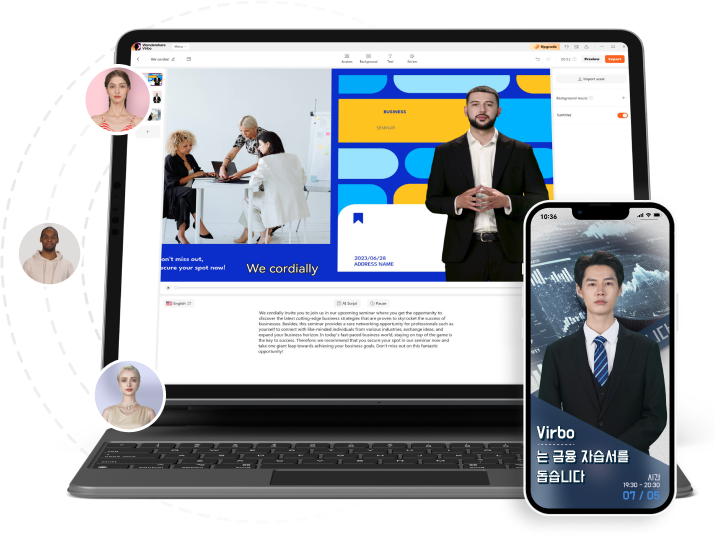
Part 2. Veed.io Translate Video: Step-by-Step Tutorial
Let’s take a look now at the step-by-step tutorial to translate a video with Veed. Note: For this Veed io translate guide, we will be translating a video using Veed on mobile.
Step 1 Launch Veed and Import Your Video
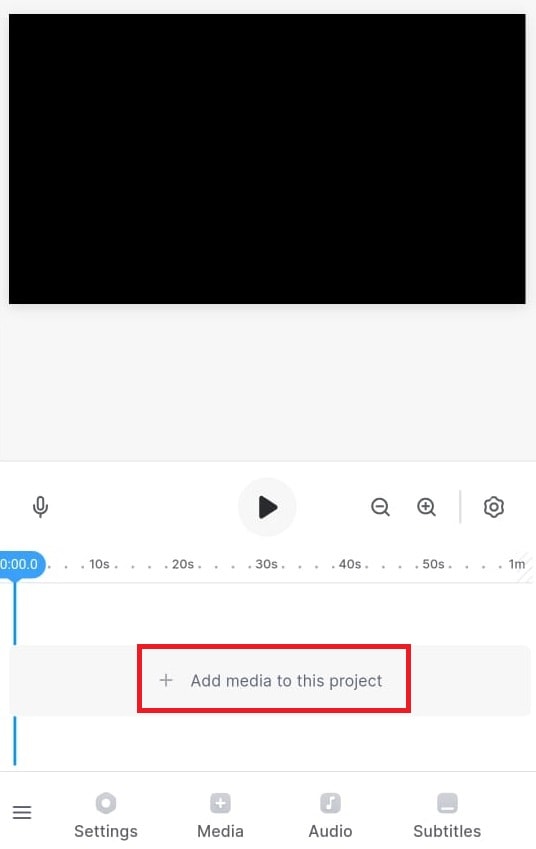
Start Veed and click on the big Add media to this project button you see in the middle. You can add audio, video, or subtitle files to the Veed platform and edit them if you want.
Step 2 Go To Project Settings
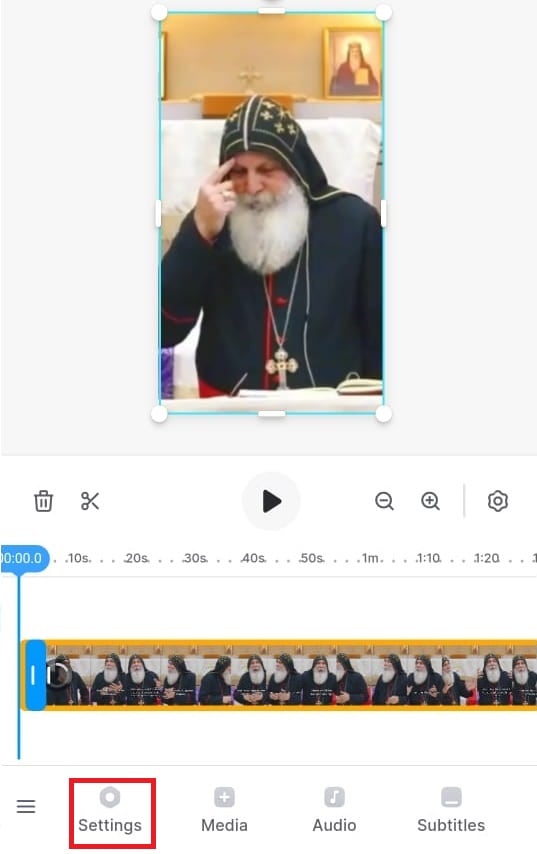
Next, go to your project’s settings by clicking the Settings button on the bottom left corner of the screen.
Step 3 Translate your Voice
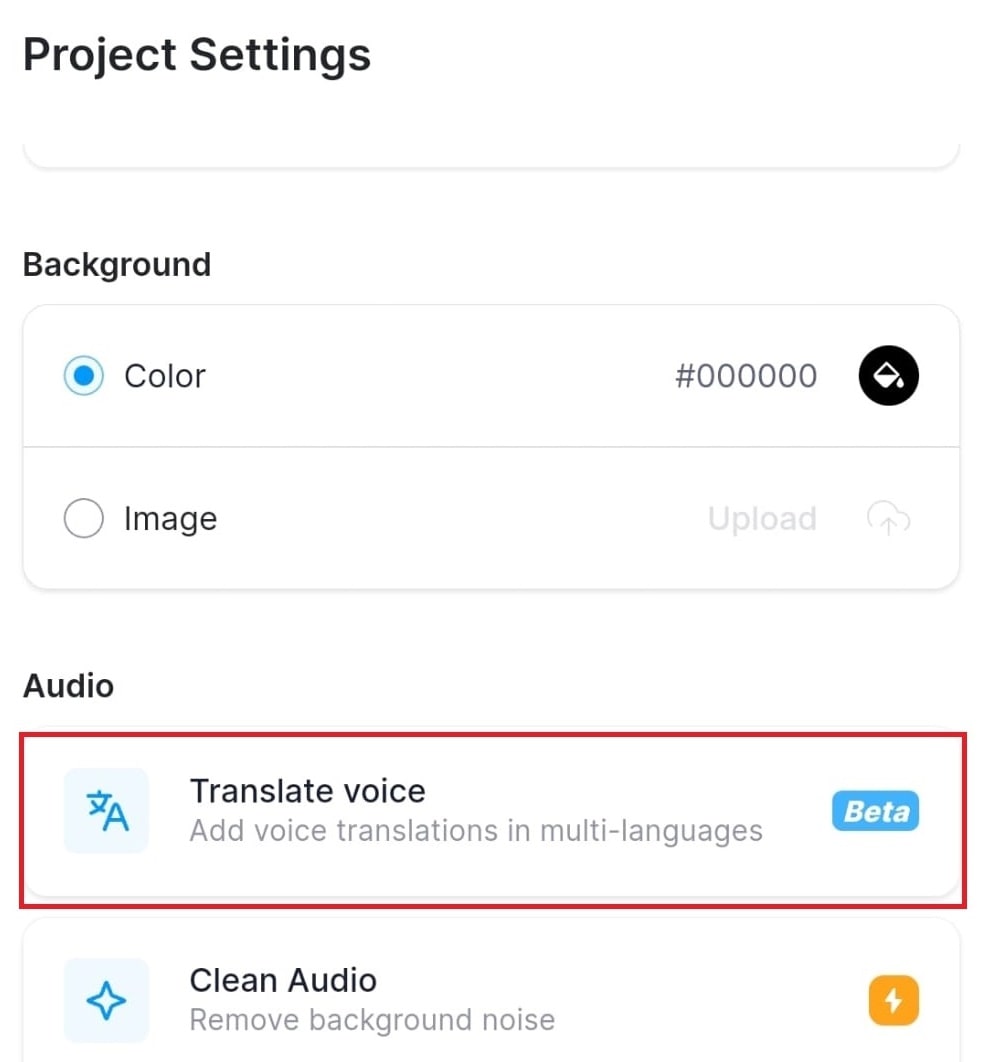
Next, click on the Translate Voice button. Note: Veed supports multiple languages. It lets you translate and then add these translations in multiple languages.
Step 4 Check Your Translation Settings

Veed automatically detects the language in the video. So, take a look at all the other settings, like the language you want to translate into and content quality and click Translate. Veed will start generating the translation in your preferred language.
Part 3: The Best Alternative to Veed.io
If you are not satisfied with the features of Veed.io, we have a better solution for you. Wondershare Virbo will prove to be the best alternative to theVeed.io translation tool. Using this advanced tool, you can select from multiple languages to get the desired translations. To carry out the translation process, you can import videos in two different formats, MP4 and MOV.
Other than video translation, users will also be able to carry out subtitle translations using this tool. Plus, this tool offers much more than translation capabilities. You can also utilize this Veed.io translate video alternative to create customized AI videos for different purposes.
Key Features of Wondershare Virbo
- Users will be able to use the lip-sync feature to create translated narrations that match the video.
- Using its talking photo functionality, you can add AI voiceovers in any language to your photos.
- Virbo provides you with an AI script feature to generate writings in multiple languages.
Advantages
- Veed.io provides very restricted minutes of translation under its subscription plans compared to Wondershare Virbo.
- Using the online version of Wondershare Virbo, you can proofread and edit the translated script.
- Veed.io is not available for offline use in Windows operating systems. However, Virbo delivers an efficient offline platform for video translation.
Translate Video Online Download APP Now Free Download
How to Translate Videos With This Veed.io Alternative
You have understood how Virbo is better than the Veed.io translation tool. Let’s analyze the method you can use to translate videos using this tool.
Step 1 Enter the Video Translator Feature from the Home Tab
Once you download Virbo from its official website, launch this Veed.io alternative on your computer. Next, hit the “Video Translator” button from its main interface after accessing the “Home” tab.
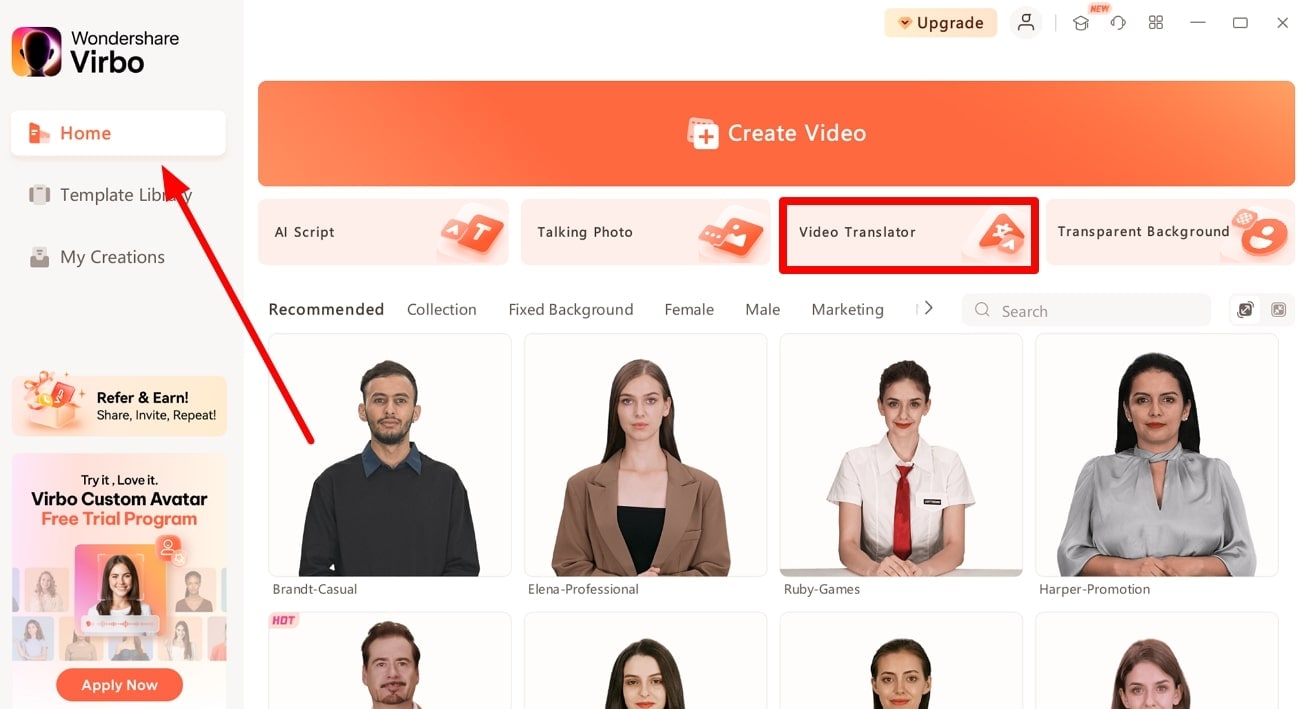
Step 2 Import Your Video to Start the Video Translation Process
Upon entering this feature, click on the “Click to Upload Video” option to add your desired video to the tool. However, there is only an option to import MP4 or MOV videos that are under 5 minutes in length.
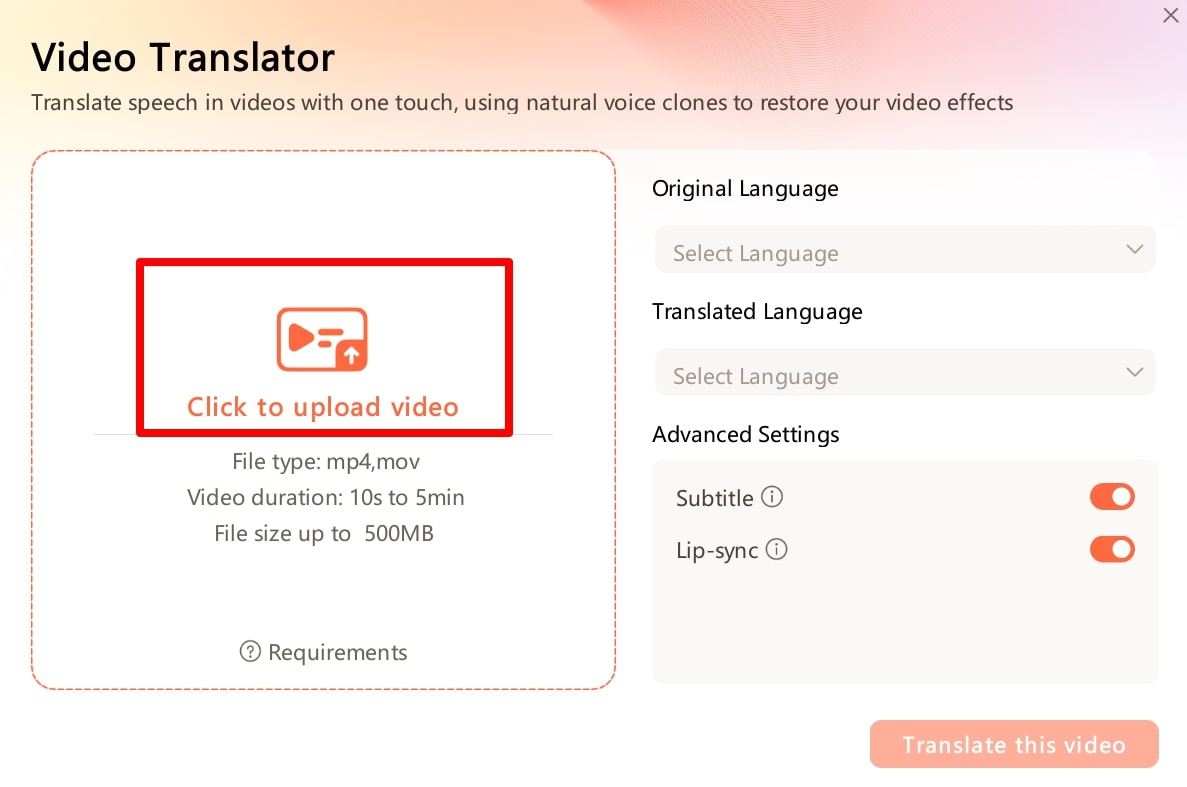
Step 3 Choose the Original and Translated Languages
After importing the video, select the original language of your video from the “Original Language” dropdown menu. Afterward, access the “Translated Language” dropdown menu to choose your desired translation language.
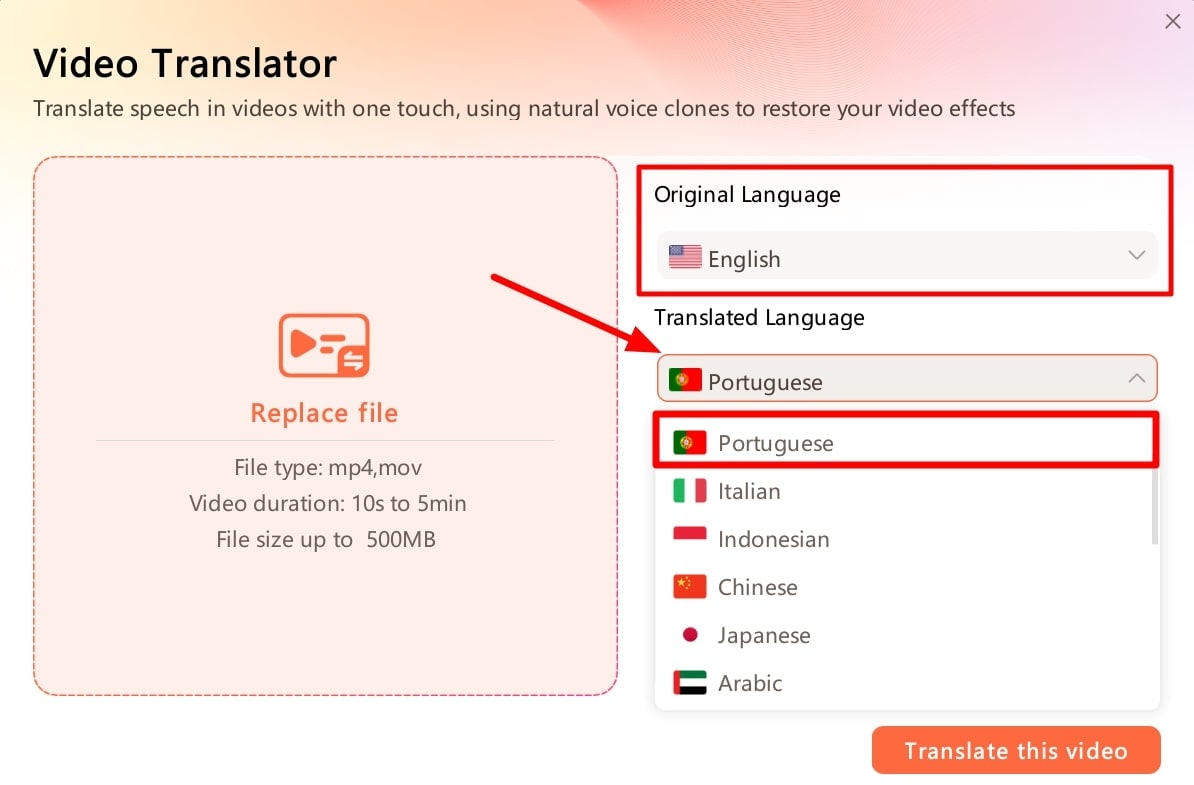
Step 4 Optimize the Advanced Video Translation Settings
Now, you can adjust the advanced settings for your video translation process. For this purpose, turn on the Subtitle option to get the video subtitles translated along with the audio. Also, enable the Lip-Sync option to generate translated audios that align with the video. Finally, hit the Translate This Video button to get your desired translated video.

Translate Video Online Download APP Now Free Download
Part 4. FAQs about Veed.io Subtitle Translation
1. How can I easily translate a video into English or any other language?
You can easily translate a video to 125+ languages of the world, including English, with an online video translator like Veed or Wondershare Virbo.
2. Are Veed translations accurate?
Veed has an accuracy percentage of 98.5, which is fantastic for an online tool. In fact, it is higher than many translation software out there.
3. Can I translate an audio file with Veed?
Yes, of course! You can easily upload any audio file in mp3 format to Veed. It will automatically translate and let you download the text file.
4. How can I download my content after it has been translated?
Simply click on the Download button when you finish the translation process. It takes just one click!
5. What makes Veed different from others?
Veed has many one-click features. For instance, auto subtitles, translations, social media formatting, templates, video compression, etc are all available in one simple click.
6. Can Veed translate subtitles?
Yes, Veed also supports translating subtitles. Simply upload your subtitle file in SRT format and leave the rest to Veed. Veed io subtitle translationis just as accurate as its video translation feature.
7. Is Veed good for editing?
Veed has many exceptional features that make content creation easy. But, it cannot replace a full-fledged video editor or help you create a new video from scratch. This is its biggest disadvantage. If you want to create a video, you can try to use Wondershare Virbo.
Conclusion
All said, Veed is a fantastic tool that makes translation into multiple languages as easy as possible. You can use the Veed translate feature to translate your video content into 125+ languages of the world, making it accessible to a larger audience. Videos in local languages get more engagement than those without because people can closely relate with the content. By adding captions in other languages, you can engage audiences from those countries, Veed supports an extensive range of content creators with their creative projects. What should you do if you want to create a video from scratch or want to try another alternative to translate video? Just try Wondershare Virbo!
Translate Video Online Download APP Now Free Download
Easily convert text into professional spokesperson videos in over 120+ voices & languages in minutes.
Generate AI Video Free Generate AI Video Now

Part 2. Veed.io Translate Video: Step-by-Step Tutorial
Let’s take a look now at the step-by-step tutorial to translate a video with Veed. Note: For this Veed io translate guide, we will be translating a video using Veed on mobile.
Step 1 Launch Veed and Import Your Video

Start Veed and click on the big Add media to this project button you see in the middle. You can add audio, video, or subtitle files to the Veed platform and edit them if you want.
Step 2 Go To Project Settings

Next, go to your project’s settings by clicking the Settings button on the bottom left corner of the screen.
Step 3 Translate your Voice

Next, click on the Translate Voice button. Note: Veed supports multiple languages. It lets you translate and then add these translations in multiple languages.
Step 4 Check Your Translation Settings

Veed automatically detects the language in the video. So, take a look at all the other settings, like the language you want to translate into and content quality and click Translate. Veed will start generating the translation in your preferred language.
Part 3: The Best Alternative to Veed.io
If you are not satisfied with the features of Veed.io, we have a better solution for you. Wondershare Virbo will prove to be the best alternative to theVeed.io translation tool. Using this advanced tool, you can select from multiple languages to get the desired translations. To carry out the translation process, you can import videos in two different formats, MP4 and MOV.
Other than video translation, users will also be able to carry out subtitle translations using this tool. Plus, this tool offers much more than translation capabilities. You can also utilize this Veed.io translate video alternative to create customized AI videos for different purposes.
Key Features of Wondershare Virbo
- Users will be able to use the lip-sync feature to create translated narrations that match the video.
- Using its talking photo functionality, you can add AI voiceovers in any language to your photos.
- Virbo provides you with an AI script feature to generate writings in multiple languages.
Advantages
- Veed.io provides very restricted minutes of translation under its subscription plans compared to Wondershare Virbo.
- Using the online version of Wondershare Virbo, you can proofread and edit the translated script.
- Veed.io is not available for offline use in Windows operating systems. However, Virbo delivers an efficient offline platform for video translation.
Translate Video Online Download APP Now Free Download
How to Translate Videos With This Veed.io Alternative
You have understood how Virbo is better than the Veed.io translation tool. Let’s analyze the method you can use to translate videos using this tool.
Step 1 Enter the Video Translator Feature from the Home Tab
Once you download Virbo from its official website, launch this Veed.io alternative on your computer. Next, hit the “Video Translator” button from its main interface after accessing the “Home” tab.

Step 2 Import Your Video to Start the Video Translation Process
Upon entering this feature, click on the “Click to Upload Video” option to add your desired video to the tool. However, there is only an option to import MP4 or MOV videos that are under 5 minutes in length.

Step 3 Choose the Original and Translated Languages
After importing the video, select the original language of your video from the “Original Language” dropdown menu. Afterward, access the “Translated Language” dropdown menu to choose your desired translation language.

Step 4 Optimize the Advanced Video Translation Settings
Now, you can adjust the advanced settings for your video translation process. For this purpose, turn on the Subtitle option to get the video subtitles translated along with the audio. Also, enable the Lip-Sync option to generate translated audios that align with the video. Finally, hit the Translate This Video button to get your desired translated video.

Translate Video Online Download APP Now Free Download
Part 4. FAQs about Veed.io Subtitle Translation
1. How can I easily translate a video into English or any other language?
You can easily translate a video to 125+ languages of the world, including English, with an online video translator like Veed or Wondershare Virbo.
2. Are Veed translations accurate?
Veed has an accuracy percentage of 98.5, which is fantastic for an online tool. In fact, it is higher than many translation software out there.
3. Can I translate an audio file with Veed?
Yes, of course! You can easily upload any audio file in mp3 format to Veed. It will automatically translate and let you download the text file.
4. How can I download my content after it has been translated?
Simply click on the Download button when you finish the translation process. It takes just one click!
5. What makes Veed different from others?
Veed has many one-click features. For instance, auto subtitles, translations, social media formatting, templates, video compression, etc are all available in one simple click.
6. Can Veed translate subtitles?
Yes, Veed also supports translating subtitles. Simply upload your subtitle file in SRT format and leave the rest to Veed. Veed io subtitle translationis just as accurate as its video translation feature.
7. Is Veed good for editing?
Veed has many exceptional features that make content creation easy. But, it cannot replace a full-fledged video editor or help you create a new video from scratch. This is its biggest disadvantage. If you want to create a video, you can try to use Wondershare Virbo.
Conclusion
All said, Veed is a fantastic tool that makes translation into multiple languages as easy as possible. You can use the Veed translate feature to translate your video content into 125+ languages of the world, making it accessible to a larger audience. Videos in local languages get more engagement than those without because people can closely relate with the content. By adding captions in other languages, you can engage audiences from those countries, Veed supports an extensive range of content creators with their creative projects. What should you do if you want to create a video from scratch or want to try another alternative to translate video? Just try Wondershare Virbo!
Translate Video Online Download APP Now Free Download
Top 10 Free Video Translators to Mitigate Translation Risks
Translating videos using AI can be a valuable asset to a company. With so many free video translators on the market, there are many tools to choose from. However, these free tools can often cause many problems, drastically increasing the risk.
So, what are these risks, and how do we mitigate these risks? Let’s find out.
Part 1. Potential Risks and Fixes of Translating Videos
Nowadays, companies are looking less and less to hire translators and leaning more towards AI. But it isn’t because of the fact that AI is more accurate. It’s because AI just takes a fraction of the time a real human has. So, what are the potential risks of translating videos? Let’s find out.
1. Accuracy
One of the biggest issues with using free video translators is the accuracy. Video translation software uses machine translation and machine learning, which can sometimes produce unpredictable and inaccurate results. Moreover, misleading translations can mess up a translated video and can potentially cause problems in the long run. This can be especially problematic for videos that contain important information, such as news broadcasts or educational content.
The fix for accuracy is to get it reviewed by a translator who can then finally confirm whether the translation was done perfectly or not. Or, you should use a tool that is known for its high accuracy, which we will discover in the next part.
2. Cultural Sensitivity
Videos often contain cultural references and humor that may not translate well into other languages. If not handled carefully, video translation can result in offensive or insensitive content. For example, we might not fully understand slang or jokes in one culture. To fix this issue, you can either simplify a video so it is understandable by everyone or use human review to explain it perfectly.
3. Technical Problems
Most free tools have problems processing a video that is mildly complex to process. If your video contains complex audio or visual elements, you might not get the most out of translation, and the tool might not even work.
Another problem is that if a video has too much background noise, then the translation tool might not even detect certain words or phrases. In other words, you should aim for a video that is high-quality and even do some pre-translation editing to make sure that the translator can do its job perfectly.
Part 2. 10 Best Free Video Translation Services
1. Wondershare Virbo
Virbo is wondershare’s free video translator that lets you translate video to English free. You can choose a plethora of video sources in various languages, and the platform will get the job done for you. For example, if you have a video in French and you want it to be translated into English, then Virbo will accurately do the job for you.
Virbo is also easy to use and effective, which means that the output you will get will be of a high quality. You can also generate an AI video with Virbo avatars that support more than 300 voices and various dialects.
Virbo is also available for Windows and Android, but if you want to use it online, you have that choice, too. Here are some of the key features of Virbo:

Get Started Online Free Download
Key Features
- Supports advanced AI features like AI Avatars, AI Voice, and AI Script Generator
- Over 300+ voices with multiple languages supported
- Easy and fast translation experience
2. Flixier

Flixier is one of the best free video translation software that allows free translations in up to 30 different languages. It helps you make your videos more accessible and you can make your videos translated within a couple of seconds of just uploading them on the platform.
Moreover, unlike many other translation tools that have the possibility of messing up, Flixier is advanced and can get the job done fairly quickly and efficiently. But the biggest benefit of using this tool is that you can edit any video right on your browser. Moreover, make a great translate video to English subtitles free app that you can use right now.
Key Features
- Translate in 30 different languages on your browser
- Fast language translator
- Allows video-to-text translation for free.
3. VEED.IO

If you are looking for the accuracy king of translation, then Veed IO will be your new best friend. It has a translation accuracy rate of a whopping 98.5%, meaning that the error margin is already too low. However, that’s not where the fun subsides. You see, Veed IO also supports a whopping list of 125+ languages that it can translate into, and the results are instant.
Looking at all these features, it’s no wonder that brands like Facebook, P&G, Hublot, and Pinterest use Veed IO to make their marketing better and their brand voice accessible to the masses.
Key Features
- Allows you to download and manipulate subtitles for further enhancements
- Highest accuracy in any video translation tool
- Over 125+ languages supported
4. HappyScribe

HappyScribe is for people who are looking to translate videos from one language to another in the most professional and effective way. The software is being used by some of the biggest companies like BBC, Forbes, Spotify, and more. From here, we can speculate that HappyScribe is mostly popular with media companies.
One of the key features of HappyScribe is that it supports various video and audio formats that are perfect for all devices. HappyScribe also makes it easier for you to translate videos since it makes the whole process easier for you.
Key Features
- A good client portfolio
- Supports over 40 video and audio formats
- Easy 4-step video translation
5. Keevi

Keevi is a perfect way to translate video to English subtitles for free. It supports over 118 languages and allows you to download these subtitles to use them for your videos later on. Keevi also provides you with valuable knowledge on how you can get ahead of the competitors by creating content that is diverse enough for the audience.
So, if you’re looking to translate any language in the world into English and then download the subtitles for your business needs, consider trying Keevi out.
Key Features
- Supports 119 languages worldwide
- Easy to use and flexible
- Supports other tools like YouTube Transcription, Chroma Key, and Video Transcription
6. CapCut

CapCut is an all-in-one video editor that is available online and on mobile operating systems as well. However, not a lot of people know that it has its own video translation tool that works efficiently. You can translate any video online for free in most languages that are popular in today’s world.
The translation tool is so famous that it is being used by companies like TikTok, Nvidia, and Mobile Legends. So, if you are looking for a translator that claims to have 100% accuracy, CapCut might be the perfect tool for you.
Key Features
- 100% video translation accuracy
- Multilingual subtitle translation
- Play, delete, and replace subtitles as you need
7. StreamLabs

StreamLabs’ Podcast Editor is one of the best tools to translate your videos online. It supports over 30+ languages with Podcast Editor and is ideal for platforms like YouTube with closed captions.
The video translation tool is faster and comes with the highest accuracy. It also supports most formats that can be then used to generate SRT, VTT, or TXT files for your translation. All in all, if you’re looking for a great free video-to-subtitle translator, then StreamLabs is a great tool for you.
Key Features
- Accurate translation of videos
- Supports most video formats
- Increase the reach and engagement of your content
8. Maestra

Maestra is another popular AI video translator software that puts ease of use at its forefront. It specializes in making things easy for you every step of the way. It does not require any credit card or even an account to work.
With Maestra, you can get your videos translated easily and effectively. That is one of the reasons why HP, ZHealth, and many other big brands use it. In just three steps, you can translate your videos from one language to another for free, with minimal effort required.
Key Features
- Get instant subtitles
- Accurate transcriptions
- Automatic AI Voiceovers
9. Kapwing

Kapwing allows you to instantly translate videos with just a few clicks. It is easy and doesn’t require any software to be installed onto your computer. Moreover, Kapwing also translates in over 70+ languages so it is highly unlikely that your language won’t be present in the list.
However, with video translations, you also get highly accurate translated subtitles. The software also grants you a fully-working video editing tool so you can add future touch-ups and enjoy them to the fullest.
Key Features
- Save time and cost to translate videos
- Automatic translations for videos, audio, and text
- Fast and highly-accurate video translations with AI
10. Media.io

Media.io is another free video translator that does its job perfectly. It automatically translates videos from one language to another without you having to do anything. Moreover, it is a free tool that isn’t too technical for an average user.
It is also the perfect tool to translate video to text but there’s also another feature that most creators use it for. With the AI power, Media IO can transform long form content into shorts so you can upload them on your platform to leverage the power of shorts.
Key Features
- Transforms long form content into short
- Easy three step video conversion
- Used by some of the biggest digital brands in the world
Part 3. Generate Free AI Video using Virbo
But what if you are looking beyond just video conversion? In that case, Virbo provides you with the most advanced AI video tool that lets you generate AI videos for free. With Virbo, you can generate AI video in minutes. All you need is well-written text, and the Virbo will turn it into a professional spokesperson that will look natural and sound all human.
Interestingly enough, the tool also offers more than 300 voices in various languages that you can leverage and take your business to the next level. Virbo is great for media companies, employees who want to present in an engaging way, educational institutions, and influencers.
It comes with multinational AI avatars, a range of natural voices, royalty-free assets & templates, and cross-platform support.

Get Started Online Free Download
Features of Virbo for Generation AI Video

- AI Avatar:
Virbo offers virtual AI avatars that will add a human touch to your videos with lifelike AI. Whether you’re doing marketing campaigns, educational videos, or more, the tool will be a landmark for the success of your business. There are 300+ real human avatars, natural human voices, 300+ voices & languages, and it also supports all age ranges.
- AI Video Translator:
As we have already discussed, Virbo offers an AI-cloning video translator with 20+ languages and solid results. It is also free for the first 3 minutes, so you can try out a project to see if it works for you. Moreover, the pricing is affordable for companies who are looking to leverage AI and take their brand to the next level.
- AI Voice:
An underrated feature of Virbo is its ability to generate AI voice from text. It uses the same expression AI and brings you AI-generated script without having to spend a lot of time getting a professional voiceover done.
Translating videos using AI can be a valuable asset to a company. With so many free video translators on the market, there are many tools to choose from. However, these free tools can often cause many problems, drastically increasing the risk.
So, what are these risks, and how do we mitigate these risks? Let’s find out.
Part 1. Potential Risks and Fixes of Translating Videos
Nowadays, companies are looking less and less to hire translators and leaning more towards AI. But it isn’t because of the fact that AI is more accurate. It’s because AI just takes a fraction of the time a real human has. So, what are the potential risks of translating videos? Let’s find out.
1. Accuracy
One of the biggest issues with using free video translators is the accuracy. Video translation software uses machine translation and machine learning, which can sometimes produce unpredictable and inaccurate results. Moreover, misleading translations can mess up a translated video and can potentially cause problems in the long run. This can be especially problematic for videos that contain important information, such as news broadcasts or educational content.
The fix for accuracy is to get it reviewed by a translator who can then finally confirm whether the translation was done perfectly or not. Or, you should use a tool that is known for its high accuracy, which we will discover in the next part.
2. Cultural Sensitivity
Videos often contain cultural references and humor that may not translate well into other languages. If not handled carefully, video translation can result in offensive or insensitive content. For example, we might not fully understand slang or jokes in one culture. To fix this issue, you can either simplify a video so it is understandable by everyone or use human review to explain it perfectly.
3. Technical Problems
Most free tools have problems processing a video that is mildly complex to process. If your video contains complex audio or visual elements, you might not get the most out of translation, and the tool might not even work.
Another problem is that if a video has too much background noise, then the translation tool might not even detect certain words or phrases. In other words, you should aim for a video that is high-quality and even do some pre-translation editing to make sure that the translator can do its job perfectly.
Part 2. 10 Best Free Video Translation Services
1. Wondershare Virbo
Virbo is wondershare’s free video translator that lets you translate video to English free. You can choose a plethora of video sources in various languages, and the platform will get the job done for you. For example, if you have a video in French and you want it to be translated into English, then Virbo will accurately do the job for you.
Virbo is also easy to use and effective, which means that the output you will get will be of a high quality. You can also generate an AI video with Virbo avatars that support more than 300 voices and various dialects.
Virbo is also available for Windows and Android, but if you want to use it online, you have that choice, too. Here are some of the key features of Virbo:

Get Started Online Free Download
Key Features
- Supports advanced AI features like AI Avatars, AI Voice, and AI Script Generator
- Over 300+ voices with multiple languages supported
- Easy and fast translation experience
2. Flixier

Flixier is one of the best free video translation software that allows free translations in up to 30 different languages. It helps you make your videos more accessible and you can make your videos translated within a couple of seconds of just uploading them on the platform.
Moreover, unlike many other translation tools that have the possibility of messing up, Flixier is advanced and can get the job done fairly quickly and efficiently. But the biggest benefit of using this tool is that you can edit any video right on your browser. Moreover, make a great translate video to English subtitles free app that you can use right now.
Key Features
- Translate in 30 different languages on your browser
- Fast language translator
- Allows video-to-text translation for free.
3. VEED.IO

If you are looking for the accuracy king of translation, then Veed IO will be your new best friend. It has a translation accuracy rate of a whopping 98.5%, meaning that the error margin is already too low. However, that’s not where the fun subsides. You see, Veed IO also supports a whopping list of 125+ languages that it can translate into, and the results are instant.
Looking at all these features, it’s no wonder that brands like Facebook, P&G, Hublot, and Pinterest use Veed IO to make their marketing better and their brand voice accessible to the masses.
Key Features
- Allows you to download and manipulate subtitles for further enhancements
- Highest accuracy in any video translation tool
- Over 125+ languages supported
4. HappyScribe

HappyScribe is for people who are looking to translate videos from one language to another in the most professional and effective way. The software is being used by some of the biggest companies like BBC, Forbes, Spotify, and more. From here, we can speculate that HappyScribe is mostly popular with media companies.
One of the key features of HappyScribe is that it supports various video and audio formats that are perfect for all devices. HappyScribe also makes it easier for you to translate videos since it makes the whole process easier for you.
Key Features
- A good client portfolio
- Supports over 40 video and audio formats
- Easy 4-step video translation
5. Keevi

Keevi is a perfect way to translate video to English subtitles for free. It supports over 118 languages and allows you to download these subtitles to use them for your videos later on. Keevi also provides you with valuable knowledge on how you can get ahead of the competitors by creating content that is diverse enough for the audience.
So, if you’re looking to translate any language in the world into English and then download the subtitles for your business needs, consider trying Keevi out.
Key Features
- Supports 119 languages worldwide
- Easy to use and flexible
- Supports other tools like YouTube Transcription, Chroma Key, and Video Transcription
6. CapCut

CapCut is an all-in-one video editor that is available online and on mobile operating systems as well. However, not a lot of people know that it has its own video translation tool that works efficiently. You can translate any video online for free in most languages that are popular in today’s world.
The translation tool is so famous that it is being used by companies like TikTok, Nvidia, and Mobile Legends. So, if you are looking for a translator that claims to have 100% accuracy, CapCut might be the perfect tool for you.
Key Features
- 100% video translation accuracy
- Multilingual subtitle translation
- Play, delete, and replace subtitles as you need
7. StreamLabs

StreamLabs’ Podcast Editor is one of the best tools to translate your videos online. It supports over 30+ languages with Podcast Editor and is ideal for platforms like YouTube with closed captions.
The video translation tool is faster and comes with the highest accuracy. It also supports most formats that can be then used to generate SRT, VTT, or TXT files for your translation. All in all, if you’re looking for a great free video-to-subtitle translator, then StreamLabs is a great tool for you.
Key Features
- Accurate translation of videos
- Supports most video formats
- Increase the reach and engagement of your content
8. Maestra

Maestra is another popular AI video translator software that puts ease of use at its forefront. It specializes in making things easy for you every step of the way. It does not require any credit card or even an account to work.
With Maestra, you can get your videos translated easily and effectively. That is one of the reasons why HP, ZHealth, and many other big brands use it. In just three steps, you can translate your videos from one language to another for free, with minimal effort required.
Key Features
- Get instant subtitles
- Accurate transcriptions
- Automatic AI Voiceovers
9. Kapwing

Kapwing allows you to instantly translate videos with just a few clicks. It is easy and doesn’t require any software to be installed onto your computer. Moreover, Kapwing also translates in over 70+ languages so it is highly unlikely that your language won’t be present in the list.
However, with video translations, you also get highly accurate translated subtitles. The software also grants you a fully-working video editing tool so you can add future touch-ups and enjoy them to the fullest.
Key Features
- Save time and cost to translate videos
- Automatic translations for videos, audio, and text
- Fast and highly-accurate video translations with AI
10. Media.io

Media.io is another free video translator that does its job perfectly. It automatically translates videos from one language to another without you having to do anything. Moreover, it is a free tool that isn’t too technical for an average user.
It is also the perfect tool to translate video to text but there’s also another feature that most creators use it for. With the AI power, Media IO can transform long form content into shorts so you can upload them on your platform to leverage the power of shorts.
Key Features
- Transforms long form content into short
- Easy three step video conversion
- Used by some of the biggest digital brands in the world
Part 3. Generate Free AI Video using Virbo
But what if you are looking beyond just video conversion? In that case, Virbo provides you with the most advanced AI video tool that lets you generate AI videos for free. With Virbo, you can generate AI video in minutes. All you need is well-written text, and the Virbo will turn it into a professional spokesperson that will look natural and sound all human.
Interestingly enough, the tool also offers more than 300 voices in various languages that you can leverage and take your business to the next level. Virbo is great for media companies, employees who want to present in an engaging way, educational institutions, and influencers.
It comes with multinational AI avatars, a range of natural voices, royalty-free assets & templates, and cross-platform support.

Get Started Online Free Download
Features of Virbo for Generation AI Video

- AI Avatar:
Virbo offers virtual AI avatars that will add a human touch to your videos with lifelike AI. Whether you’re doing marketing campaigns, educational videos, or more, the tool will be a landmark for the success of your business. There are 300+ real human avatars, natural human voices, 300+ voices & languages, and it also supports all age ranges.
- AI Video Translator:
As we have already discussed, Virbo offers an AI-cloning video translator with 20+ languages and solid results. It is also free for the first 3 minutes, so you can try out a project to see if it works for you. Moreover, the pricing is affordable for companies who are looking to leverage AI and take their brand to the next level.
- AI Voice:
An underrated feature of Virbo is its ability to generate AI voice from text. It uses the same expression AI and brings you AI-generated script without having to spend a lot of time getting a professional voiceover done.
Also read:
- [New] In 2024, Fading Audio Tracks with Ease in Adobe Premiere Pro
- 2024 Approved 10 Preferred Online Photo Background Swappers
- 2024 Approved The Best Translator to Translate Videos Online
- Can You Fix Defective Computer Components? - Expert Tips From YL Computing & Software Solutions
- Fixing Foneazy MockGo Not Working On Honor Magic 5 Pro | Dr.fone
- In 2024, Mastering Lip Sync Explore Top Apps for Dynamic Videos
- New 2024 Approved Must-Have Apps for Real-Time Video Translation
- New Best 5 Udemy Subtitle Translator (Auto Translation)
- New Get Started with Final Cut Pro Flipping Videos Made Easy
- Unlocking iTunes Backup Files: A Comprehensive How-To for Users
- Updated Translate Videos and Subtitles with Veed.io
- Title: Updated Step-by-Step Guide How to Translate Twitter Video Easily for 2024
- Author: Susan
- Created at : 2025-02-17 16:34:23
- Updated at : 2025-02-19 16:59:05
- Link: https://ai-video-translation.techidaily.com/updated-step-by-step-guide-how-to-translate-twitter-video-easily-for-2024/
- License: This work is licensed under CC BY-NC-SA 4.0.

